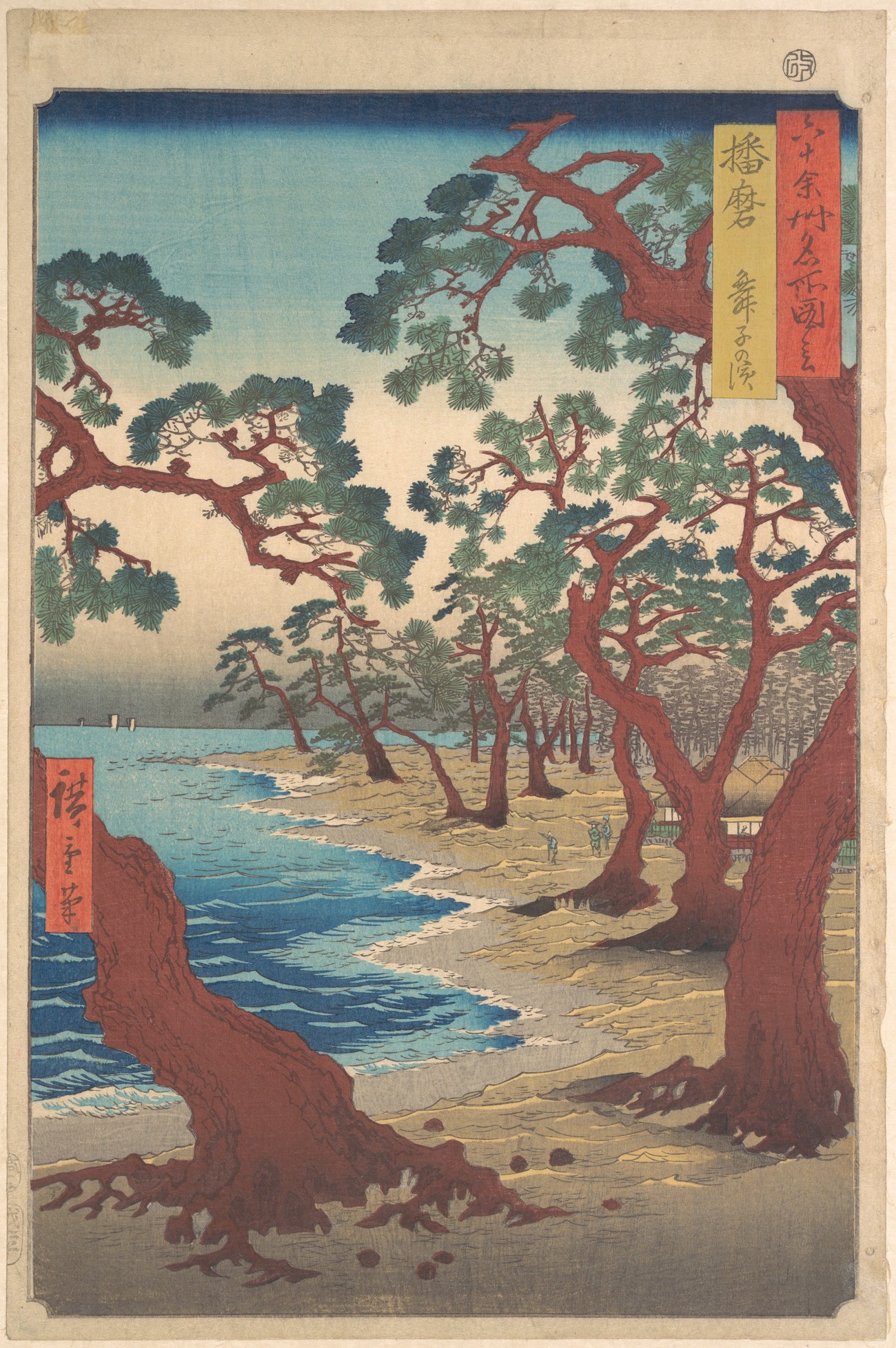 Kiri-mon |
 Katakura-mon |
-
 Iron tsuba of round form decorated with eight roundels – circular emblems of flowers and/or family crests (mon) made of cast brass, pierced and chiselled in kebori, and with flat brass inlay (hira-zōgan) of vines or leaves all over the plate. Both hitsu-ana are trimmed with brass. Nakago-ana of trapezoidal form. A distinctive character of this tsuba is a mon at 12 hours, depicting paulownia, or Kiri-mon [桐紋] – a symbol of the Toyotomi clan, led by Toyotomi Hideyoshi (豊臣 秀吉, 1537 – 1598). Kiri-mon was also used as fuku-mon (alternative family crests) for the Imperial Family and Imperial Court. Another important emblem at 6 o’clock is the Katakura clan [片倉氏, Katakura-shi] family crest. Katakura Kagetsuna (片倉 景綱, 1557 – 1615), a retainer of Date Masamune (伊達 政宗, 1567 – 1636); Kagetsuna was operational in Hideyoshi’s Odawara campaign in 1590, which ultimately ended the unification of Japan. Unsigned but may be attributed to Koike Yoshirō Naomasa or his workshop (Yoshirō, orKaga-Yoshirō school). Dimensions: Diameter: 85.5 mm; Thickness at seppa-dai: 5.0 mm.
Iron tsuba of round form decorated with eight roundels – circular emblems of flowers and/or family crests (mon) made of cast brass, pierced and chiselled in kebori, and with flat brass inlay (hira-zōgan) of vines or leaves all over the plate. Both hitsu-ana are trimmed with brass. Nakago-ana of trapezoidal form. A distinctive character of this tsuba is a mon at 12 hours, depicting paulownia, or Kiri-mon [桐紋] – a symbol of the Toyotomi clan, led by Toyotomi Hideyoshi (豊臣 秀吉, 1537 – 1598). Kiri-mon was also used as fuku-mon (alternative family crests) for the Imperial Family and Imperial Court. Another important emblem at 6 o’clock is the Katakura clan [片倉氏, Katakura-shi] family crest. Katakura Kagetsuna (片倉 景綱, 1557 – 1615), a retainer of Date Masamune (伊達 政宗, 1567 – 1636); Kagetsuna was operational in Hideyoshi’s Odawara campaign in 1590, which ultimately ended the unification of Japan. Unsigned but may be attributed to Koike Yoshirō Naomasa or his workshop (Yoshirō, orKaga-Yoshirō school). Dimensions: Diameter: 85.5 mm; Thickness at seppa-dai: 5.0 mm. -
 Iron tsuba of round form decorated with eight circular emblems of flowers and/or family crests (mon) made of cast brass, pierced and chiseled in kebori, as well as with flat brass inlay (hira-zōgan) of vines, leaves, and flowers all over the plate. Yoshirō school (Kaga-Yoshirō). The Momoyama or early Edo period, 17th century. Size: diameter 80 mm, thickness at seppa-dai 3,6 mm. Symbols: [12:00 o'clock] - Wood sorrel (katabami) and swords ; [9:00] - Cherry blossom (sakura); [7:30] - Bellflower (kikyō), kamon of Toki clan; [3:00] - possibly, a six-petal Chrysanthemum (kiku) or a Passion flower (tessen); [1:30] - Hemp (asanoha). The symbols at 6:00, 10:30, and 4:30 o'clock seem to be geometrical patterns of auspicious meaning: a cross in a square, a four pointing star, and a diamond, respectively. Alternatively, we may look at this piece as purely decorative, with patterns at 12:00, 3:00, 6:00, and 9:00 o'clock in negative openwork (in-sukashi), and at 1:30, 4:40, 7:20, and 10:30 o'clock - in positive openwork (ji-sukashi, or yō-sukashi). Markus Sesko in his Handbook of sword fittings related terms [Herstellung und Verlag: Books on Demand GmbH, Norderstedt, 2011] discriminates this type of openwork in a separate class: Ranma-sukashi: "This term is applied to circular sukashi with family crests to their inside, which are arranged running along the rim area. The description goes back to the opened boards (ranma) between the sliding doors and the ceiling of Japanese rooms. Ranma-sukashi are mostly seen on old Heianjō- or Yoshirō-zōgan-tsuba but also on works of Hayashi Matashichi" [page 30].
Iron tsuba of round form decorated with eight circular emblems of flowers and/or family crests (mon) made of cast brass, pierced and chiseled in kebori, as well as with flat brass inlay (hira-zōgan) of vines, leaves, and flowers all over the plate. Yoshirō school (Kaga-Yoshirō). The Momoyama or early Edo period, 17th century. Size: diameter 80 mm, thickness at seppa-dai 3,6 mm. Symbols: [12:00 o'clock] - Wood sorrel (katabami) and swords ; [9:00] - Cherry blossom (sakura); [7:30] - Bellflower (kikyō), kamon of Toki clan; [3:00] - possibly, a six-petal Chrysanthemum (kiku) or a Passion flower (tessen); [1:30] - Hemp (asanoha). The symbols at 6:00, 10:30, and 4:30 o'clock seem to be geometrical patterns of auspicious meaning: a cross in a square, a four pointing star, and a diamond, respectively. Alternatively, we may look at this piece as purely decorative, with patterns at 12:00, 3:00, 6:00, and 9:00 o'clock in negative openwork (in-sukashi), and at 1:30, 4:40, 7:20, and 10:30 o'clock - in positive openwork (ji-sukashi, or yō-sukashi). Markus Sesko in his Handbook of sword fittings related terms [Herstellung und Verlag: Books on Demand GmbH, Norderstedt, 2011] discriminates this type of openwork in a separate class: Ranma-sukashi: "This term is applied to circular sukashi with family crests to their inside, which are arranged running along the rim area. The description goes back to the opened boards (ranma) between the sliding doors and the ceiling of Japanese rooms. Ranma-sukashi are mostly seen on old Heianjō- or Yoshirō-zōgan-tsuba but also on works of Hayashi Matashichi" [page 30]. -
 Iron tsuba of round form decorated with eight roundels - circular emblems of flowers and/or family crests (mon) made of cast brass, pierced and chiseled in kebori, and with flat brass inlay (hira-zōgan) of vines or seaweed all over the plate. Hitsu-ana outlined in brass. Four positive silhouette roundels are 3-, 4-, 5-, and 6- pointing crests/flowers; four negative silhouette roundels are bellflower, cherry blossom, and suhama. Yoshirō school (Kaga-Yoshirō). The Momoyama or early Edo period, beginning of 17th century. Size: diameter 77 mm, thickness 3,8 mm
Iron tsuba of round form decorated with eight roundels - circular emblems of flowers and/or family crests (mon) made of cast brass, pierced and chiseled in kebori, and with flat brass inlay (hira-zōgan) of vines or seaweed all over the plate. Hitsu-ana outlined in brass. Four positive silhouette roundels are 3-, 4-, 5-, and 6- pointing crests/flowers; four negative silhouette roundels are bellflower, cherry blossom, and suhama. Yoshirō school (Kaga-Yoshirō). The Momoyama or early Edo period, beginning of 17th century. Size: diameter 77 mm, thickness 3,8 mm -

Iron tsuba of round form decorated with eight roundels – circular emblems of flowers and/or family crests (mon) made of cast brass, pierced and chiseled in kebori, and with flat brass inlay (hira-zōgan) of vines or leaves all over the plate. Both hitsu-ana could have been trimmed with brass now lacking. Nakago-ana of triangular form, possibly enlarged, with copper sekigane. All typical emblems with bellflower, two variations on suhama theme, and 3, 4, 5, and 6-poinitng mon variations. A distinctive character of this tsuba is a mon at 12 hours depicting water plantain (omodaka).
“Omodaka was also called shōgunsō (victorious army grass); because of this martial connotation, it was a design favored for the crests of samurai families” [Family crests of Japan, Stone Bridge Press, Berkeley, California]. Yoshirō school (Kaga-Yoshirō). The Momoyama or early Edo period, beginning of 17th century. Size: Height: 81.4 mm; width: 81.2; thickness 3.8 mm at seppa-dai. -
 Iron tsuba of round form decorated with eight roundels – circular emblems of flowers and/or family crests (mon) made of cast brass, pierced and chiselled in kebori, and with flat brass inlay (hira-zōgan) of vines or leaves all over the plate. Both hitsu-ana trimmed with brass. Nakago-ana of trapezoidal form. A distinctive character of this tsuba is a mon at 6 hours depicting tomoe (comma). Yoshirō school (Kaga-Yoshirō). Attributed to Koike Yoshirō Naomasa himself. Unsigned. The Momoyama or early Edo period, end of the 16th to the first half of the 17th century (1574-1650). Size: Diameter 82.0 mm, thickness 3.8 mm at seppa-dai, 3.4 mm at rim.
Iron tsuba of round form decorated with eight roundels – circular emblems of flowers and/or family crests (mon) made of cast brass, pierced and chiselled in kebori, and with flat brass inlay (hira-zōgan) of vines or leaves all over the plate. Both hitsu-ana trimmed with brass. Nakago-ana of trapezoidal form. A distinctive character of this tsuba is a mon at 6 hours depicting tomoe (comma). Yoshirō school (Kaga-Yoshirō). Attributed to Koike Yoshirō Naomasa himself. Unsigned. The Momoyama or early Edo period, end of the 16th to the first half of the 17th century (1574-1650). Size: Diameter 82.0 mm, thickness 3.8 mm at seppa-dai, 3.4 mm at rim. -
 Iron tsuba of round form, tapering from centre to the rim, decorated with eight roundels – circular emblems of flowers and/or family crests (mon) made of cast brass, pierced and chiselled in kebori, and with flat brass inlay (hira-zōgan) of water plantain (omodaka) and seaweed all over the plate. Hitsu-ana outlined in brass. Four positive silhouette roundels are 3-, 6-, 9-, and 12 – pointing crests/flowers; four negative silhouette roundels – bellflower, cherry and plum blossoms. Yoshirō school (Kaga-Yoshirō). Unsigned. The Momoyama or early Edo period, end of the 16th to the first half of the 17th century (1574-1650). Size: H: 88.3 mm; W: 88.7 mm; Thickness 4.0 mm (Seppa-dai), 3,2 cm (rim). Other Kaga-Yoshiro tsuba in this collection: TSU-0334: 7.7 cm; TSU-0342.2017: 89.6 cm; TSU-0344: 8.1 cm; TSU-0329: 8.0 cm; TSU-0376.2018: 8.1 cm; TSU-0379.2018: 8.2 cm. We see that the usual size is about 8 cm; larger pieces, such as this one and TSU-0342.2017 dedicated to Hachiman, are rare. Article about Yoshiro tsuba.
Iron tsuba of round form, tapering from centre to the rim, decorated with eight roundels – circular emblems of flowers and/or family crests (mon) made of cast brass, pierced and chiselled in kebori, and with flat brass inlay (hira-zōgan) of water plantain (omodaka) and seaweed all over the plate. Hitsu-ana outlined in brass. Four positive silhouette roundels are 3-, 6-, 9-, and 12 – pointing crests/flowers; four negative silhouette roundels – bellflower, cherry and plum blossoms. Yoshirō school (Kaga-Yoshirō). Unsigned. The Momoyama or early Edo period, end of the 16th to the first half of the 17th century (1574-1650). Size: H: 88.3 mm; W: 88.7 mm; Thickness 4.0 mm (Seppa-dai), 3,2 cm (rim). Other Kaga-Yoshiro tsuba in this collection: TSU-0334: 7.7 cm; TSU-0342.2017: 89.6 cm; TSU-0344: 8.1 cm; TSU-0329: 8.0 cm; TSU-0376.2018: 8.1 cm; TSU-0379.2018: 8.2 cm. We see that the usual size is about 8 cm; larger pieces, such as this one and TSU-0342.2017 dedicated to Hachiman, are rare. Article about Yoshiro tsuba. -
 Well-forged iron plate of round shape (maru-gata) is decorated with water weeds or arabesque (karakusa) in flat brass inlay (hira-zōgan) all over and eight family crests (mon) of round form in cast brass with delicate linear carving (kebori) and openwork (sukashi). Crests represent: [at 9 hours] three counter-clockwise commas or swirls (tomoe); [at 10:30] plum blossom (ume); [at 12:00, 1:130, and 7:30] - stylized flower made by cutting out five suhama symblos (flower-shaped suhama); [at 3:00] bellflower (kikyō); [at 4:30] seven-star crest (shichiyō-mon); [at 6:00] cherry blossom (sakura). Brass-trimmed ryo-hitsu. Copper sekigane. Yoshirō school. Momoyama or early Edo period, end of the 16th to first half of the 17th century (1574-1650). Inscription on seppa-dai: 八幡 - Hachiman. Size: height 89.6 mm, width 89.3 mm, thickness at seppa-dai 3,0 mm. Weight 129.7 g. NBTHK certificate № 4007685, June 27, 2015: HOZON (Worthy of Preservation). As for the inscription, Nihonto Message Board blog discussion provides the following explanation of the inscription: "An expression of conviction as to being the best under the sun". On the other hand, there may be more in this confluence of symbols: the tomoe crest at 9:00 is "the kamon of Hachiman, the war god" [Family Crests of Japan; Stone Bridge Press, Berkeley, CA, 2007, p. 108]. The character 八 in the inscription cut stronger than the other kanji, and may be by a different hand in different time. 八 (hachi, eight): "The numeral eight was appreciated because its shape broadens toward the bottom, symbolizing eternal expansion" [ibid, p. 119]. It may be said that this tsuba is dedicated to Hachiman. Other crests (suhama, bellflower, seven-stars, plum and cherry blossoms) collectively allude to "good old times" when Fijiwara and Taira clans were in full bloom. Markus Sesko believes that the inscriptions reads: Hachiman: "the inscription is/was HACHIMAN (八幡), the God of War and a relatively popular inscription for tsuba, swords and armor." Elliott Long and Robert Haynes provide the following explanation of the inscription: "...hachi is correct and represents the name of the HACHI SHRINE. The inscription reads 'YAWATA' which is the name of the mountain in Mino Province where the HACHI Shrine is located". Details on Hachiman Shrine in Yawata (八幡市) can be found elsewhere, including Historical and geographical dictionary of Japan by Edmond Papinot. Van Ham auction house provides the following description: MON-SUKASHI TSUBA. MARUGATA. Japan. Momoyama period. Yoshiro school. Iron with inlays of brass. In hira-zogan technique with kebori engraving eight different family emblems (mon). An old inscription is dedicated to the deity Hachiman. D.4.5mm, Ø 8.3cm. Condition A/B. Supplement: Wooden box and NBTHK certificate.
Well-forged iron plate of round shape (maru-gata) is decorated with water weeds or arabesque (karakusa) in flat brass inlay (hira-zōgan) all over and eight family crests (mon) of round form in cast brass with delicate linear carving (kebori) and openwork (sukashi). Crests represent: [at 9 hours] three counter-clockwise commas or swirls (tomoe); [at 10:30] plum blossom (ume); [at 12:00, 1:130, and 7:30] - stylized flower made by cutting out five suhama symblos (flower-shaped suhama); [at 3:00] bellflower (kikyō); [at 4:30] seven-star crest (shichiyō-mon); [at 6:00] cherry blossom (sakura). Brass-trimmed ryo-hitsu. Copper sekigane. Yoshirō school. Momoyama or early Edo period, end of the 16th to first half of the 17th century (1574-1650). Inscription on seppa-dai: 八幡 - Hachiman. Size: height 89.6 mm, width 89.3 mm, thickness at seppa-dai 3,0 mm. Weight 129.7 g. NBTHK certificate № 4007685, June 27, 2015: HOZON (Worthy of Preservation). As for the inscription, Nihonto Message Board blog discussion provides the following explanation of the inscription: "An expression of conviction as to being the best under the sun". On the other hand, there may be more in this confluence of symbols: the tomoe crest at 9:00 is "the kamon of Hachiman, the war god" [Family Crests of Japan; Stone Bridge Press, Berkeley, CA, 2007, p. 108]. The character 八 in the inscription cut stronger than the other kanji, and may be by a different hand in different time. 八 (hachi, eight): "The numeral eight was appreciated because its shape broadens toward the bottom, symbolizing eternal expansion" [ibid, p. 119]. It may be said that this tsuba is dedicated to Hachiman. Other crests (suhama, bellflower, seven-stars, plum and cherry blossoms) collectively allude to "good old times" when Fijiwara and Taira clans were in full bloom. Markus Sesko believes that the inscriptions reads: Hachiman: "the inscription is/was HACHIMAN (八幡), the God of War and a relatively popular inscription for tsuba, swords and armor." Elliott Long and Robert Haynes provide the following explanation of the inscription: "...hachi is correct and represents the name of the HACHI SHRINE. The inscription reads 'YAWATA' which is the name of the mountain in Mino Province where the HACHI Shrine is located". Details on Hachiman Shrine in Yawata (八幡市) can be found elsewhere, including Historical and geographical dictionary of Japan by Edmond Papinot. Van Ham auction house provides the following description: MON-SUKASHI TSUBA. MARUGATA. Japan. Momoyama period. Yoshiro school. Iron with inlays of brass. In hira-zogan technique with kebori engraving eight different family emblems (mon). An old inscription is dedicated to the deity Hachiman. D.4.5mm, Ø 8.3cm. Condition A/B. Supplement: Wooden box and NBTHK certificate. -
 Iron tsuba of round form decorated with eight roundels – circular emblems of flowers and/or family crests (mon) made of cast brass, pierced and chiseled in kebori, and with flat brass inlay (hira-zōgan) of vines or leaves all over the plate. Both hitsu-ana trimmed in brass. Nakago-ana of rectangular form, with copper sekigane. Four positive openwork (ji-sukashi) roundels at 12, 3, 6, and 9 o'clock; and four negative openwork (in-sukashi) roundels with cherry blossom, bellflower, and two variations on suhama theme. Yoshirō school (Kaga-Yoshirō). The Momoyama or early Edo period, late 16th to early 17th century. Size: diameter 81.4 mm, thickness 4.7 mmat seppa-dai, 4.0 mm at rim. Christie's lot description: AN IRON TSUBA; EDO PERIOD (17TH CENTURY). THE DOLPHYN COLLECTION OF SAMURAI ART. The round iron tsuba pierced with roundels of various floral motifs interspersed among scrolling foliage, all inlaid with brass. 8.1 cm. high. Provenance: Pabst Collection (no. 338).
Iron tsuba of round form decorated with eight roundels – circular emblems of flowers and/or family crests (mon) made of cast brass, pierced and chiseled in kebori, and with flat brass inlay (hira-zōgan) of vines or leaves all over the plate. Both hitsu-ana trimmed in brass. Nakago-ana of rectangular form, with copper sekigane. Four positive openwork (ji-sukashi) roundels at 12, 3, 6, and 9 o'clock; and four negative openwork (in-sukashi) roundels with cherry blossom, bellflower, and two variations on suhama theme. Yoshirō school (Kaga-Yoshirō). The Momoyama or early Edo period, late 16th to early 17th century. Size: diameter 81.4 mm, thickness 4.7 mmat seppa-dai, 4.0 mm at rim. Christie's lot description: AN IRON TSUBA; EDO PERIOD (17TH CENTURY). THE DOLPHYN COLLECTION OF SAMURAI ART. The round iron tsuba pierced with roundels of various floral motifs interspersed among scrolling foliage, all inlaid with brass. 8.1 cm. high. Provenance: Pabst Collection (no. 338). -
 The so-called Yoshirō-tsuba [与四郎鐔] with an iron plate of mokkō form densely decorated with floral arabesque and adorned with eight pierced, chiselled and inlaid brass roundels and signed on both sides 'Koike Yoshirō Izumi no Kami Naomasa'. Four of the roundels are pierced and have geometrical designs representing flowers (e.g. wood sorrel) or snowflakes. Four others are solid and represent family crests; on one side: Mulberry (kaji) – mon of the Matsunaga clan [松永氏], Bamboo Grass (sasa) – mon of the Takenaka clan [竹中氏]), Wild Geese (kari) – mon of the Shibata clan [新発田氏]), and Pine Needles (matsuba); on the other side: Nine Stars (kuyō) – the Hosokawa clan [細川氏], Paulownia (kiri) – the Toyotomi clan [豊臣氏]), Bamboo Leaves (take) – the Minamoto clan [源], and Seven Treasures (shippo) – Izumo Genji clan [出雲源氏]. Hitsu-ana obliterated with a nanako-treated pewter plug. Brass with rainbow patina. Artist: Koike Izumi no Kami Naomasa (Japanese, active late 16th – early 17th century). The Momoyama or early Edo period, end of the 16th to the first half of the 17th century (1574-1650). Size: 81.7 x 78.8 x 4.3 cm. Provenance: Dr. Kazutaro Torigoye. Special thanks to Markus Sesko for providing the translation of hakogaki. Hakokaki lid (outside): 小池与四郎 – Koike Yoshirō Hakokaki lid (inside): 銘曰小池与四郎 – Mei’etsu: Koike Yoshirō – Signed: Koike Yoshirō 和泉守直正 – Izumi no Kami Naomasa – Izumi no Kami Naomasa 木瓜形 鉄地 – Mokkōgata, tetsu-ji – Lobed shape, of iron 真鍮据紋象嵌 – Shinchū suemon-zōgan – with brass suemon-zōgan inlay 縦二寸七分横二寸六分 – Tate ni-sun shichi-bu, yoko ni-sun roku-bu – Height 8.2 cm, width 7.9 cm 右正真也 – Migi shōshin nari – Above described object is authentic 昭和廾九年八月十一日 – Shōwa nijūkyūnen hachigatsu jūichinichi – August 11, 1954 草堂「花押」– Sōdō + kaō – Sōdō [pen name of Torigoye Kazutarō, 鳥越一太郎] + monogram Ref.: (1) Tsuba Geijutsu-Ko by Kazutaro Torigoye, 1960; (2) Tsuba. An aesthetic study. By Kazutaro Torigoye and Robert E. Haynes from the Tsuba Geijutsu-kō of Kazataro Torigoye. Edited and published by Alan L. Harvie for the Nothern California Japanese Sword Club, 1994-1997, p. Yoshirō, 4. See also Yoshirō tsuba.
The so-called Yoshirō-tsuba [与四郎鐔] with an iron plate of mokkō form densely decorated with floral arabesque and adorned with eight pierced, chiselled and inlaid brass roundels and signed on both sides 'Koike Yoshirō Izumi no Kami Naomasa'. Four of the roundels are pierced and have geometrical designs representing flowers (e.g. wood sorrel) or snowflakes. Four others are solid and represent family crests; on one side: Mulberry (kaji) – mon of the Matsunaga clan [松永氏], Bamboo Grass (sasa) – mon of the Takenaka clan [竹中氏]), Wild Geese (kari) – mon of the Shibata clan [新発田氏]), and Pine Needles (matsuba); on the other side: Nine Stars (kuyō) – the Hosokawa clan [細川氏], Paulownia (kiri) – the Toyotomi clan [豊臣氏]), Bamboo Leaves (take) – the Minamoto clan [源], and Seven Treasures (shippo) – Izumo Genji clan [出雲源氏]. Hitsu-ana obliterated with a nanako-treated pewter plug. Brass with rainbow patina. Artist: Koike Izumi no Kami Naomasa (Japanese, active late 16th – early 17th century). The Momoyama or early Edo period, end of the 16th to the first half of the 17th century (1574-1650). Size: 81.7 x 78.8 x 4.3 cm. Provenance: Dr. Kazutaro Torigoye. Special thanks to Markus Sesko for providing the translation of hakogaki. Hakokaki lid (outside): 小池与四郎 – Koike Yoshirō Hakokaki lid (inside): 銘曰小池与四郎 – Mei’etsu: Koike Yoshirō – Signed: Koike Yoshirō 和泉守直正 – Izumi no Kami Naomasa – Izumi no Kami Naomasa 木瓜形 鉄地 – Mokkōgata, tetsu-ji – Lobed shape, of iron 真鍮据紋象嵌 – Shinchū suemon-zōgan – with brass suemon-zōgan inlay 縦二寸七分横二寸六分 – Tate ni-sun shichi-bu, yoko ni-sun roku-bu – Height 8.2 cm, width 7.9 cm 右正真也 – Migi shōshin nari – Above described object is authentic 昭和廾九年八月十一日 – Shōwa nijūkyūnen hachigatsu jūichinichi – August 11, 1954 草堂「花押」– Sōdō + kaō – Sōdō [pen name of Torigoye Kazutarō, 鳥越一太郎] + monogram Ref.: (1) Tsuba Geijutsu-Ko by Kazutaro Torigoye, 1960; (2) Tsuba. An aesthetic study. By Kazutaro Torigoye and Robert E. Haynes from the Tsuba Geijutsu-kō of Kazataro Torigoye. Edited and published by Alan L. Harvie for the Nothern California Japanese Sword Club, 1994-1997, p. Yoshirō, 4. See also Yoshirō tsuba. -

Small iron tsuba for a dagger (tantō), of quatrefoil form (mokkō-gata), with raised rim (mimi), decorated with flat brass inlay (hira-zōgan) to form an abstract design alluding to the mushroom of immortality (reishi). Opening (hitsu-ana) to the left of nakaga-ana probably cut later and fitted with shakudo sekigane. Maker's signature on seppa-dai: Koike Naomasa (小池 直正).
Momoyama period: End of the 16th - beginning of the 17th century. Dimensions: Height 53.7 mm; Width: 45.5 mm; Thickness at centre: 3.5 mm; at rim: 4.9 mm. Other examples of signed Koike Naomasa work in this collection: TSU-0346. Reference: The closest example in literature is in Compton Collection (II): №11 with the description: “A Koike School tsuba, Edo period (circa 1625), signed Koike Yoshiro. Sheet-brass flush inlay of cloud forms and wire inlay creating the same shape. Koike Yoshiro Naomasa worked from the Keicho to the Genna periods (1596-1623). He arrived in Kyoto from Kaga.” [Japanese Swords and Sword Fittings from the Collection of Dr. Walter Ames Compton (Part II) / Sebastian Izzard, Yoshinori Munemura. — Christie's, New York, October 22, 1992]. See: Yoshirō tsuba.
-
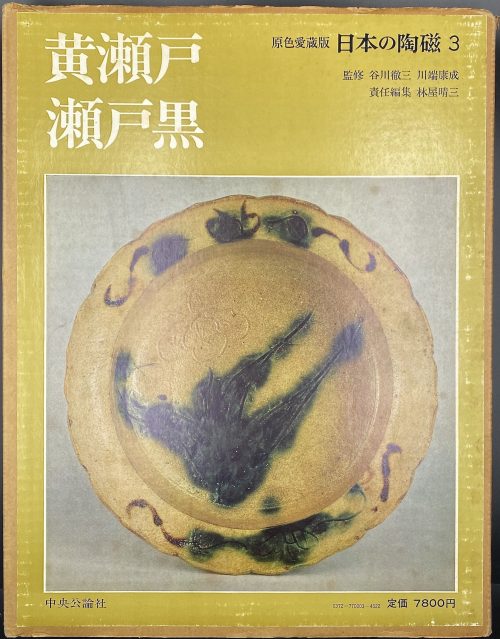 Hardcover volume, 35.3 x 27 cm, bound in grey cloth, blind stamped characters to front, brown characters to spine, in a glassine dust jacket, in a double slipcase, the outer case pictorial paper over cardboard, 36 x 28 cm, pp.: [4] [1] 2-88 (plates with photographs of 129 items), [2] 91-108 [3]. Seto ware [瀬戸焼] (Seto-yaki) – ceramics produced in and around the city of Seto in Aichi Prefecture. Yellow seto [黄瀬戸] (Kiseto) – a yellow glaze seto ware. Black seto [瀬戸黒] (Setoguro) – a black glaze seto ware. 日本の陶磁 – Japanese ceramics, series title. Contributors: Yasunari Kawabata [川端 康成] (Japanese, 1924 – 1972) – author. Tetsuzo Tanikawa [谷川 徹三] (Japanese, 1895 – 1989) – author. Seizo Hayashiya [林屋晴三] (Japanese, 1928 – 2017) – editor. Chūōkōron-sha [中央公論社] – publisher.
Hardcover volume, 35.3 x 27 cm, bound in grey cloth, blind stamped characters to front, brown characters to spine, in a glassine dust jacket, in a double slipcase, the outer case pictorial paper over cardboard, 36 x 28 cm, pp.: [4] [1] 2-88 (plates with photographs of 129 items), [2] 91-108 [3]. Seto ware [瀬戸焼] (Seto-yaki) – ceramics produced in and around the city of Seto in Aichi Prefecture. Yellow seto [黄瀬戸] (Kiseto) – a yellow glaze seto ware. Black seto [瀬戸黒] (Setoguro) – a black glaze seto ware. 日本の陶磁 – Japanese ceramics, series title. Contributors: Yasunari Kawabata [川端 康成] (Japanese, 1924 – 1972) – author. Tetsuzo Tanikawa [谷川 徹三] (Japanese, 1895 – 1989) – author. Seizo Hayashiya [林屋晴三] (Japanese, 1928 – 2017) – editor. Chūōkōron-sha [中央公論社] – publisher. -

Circular tsuba (marugata ) with design of futatsu-domoe (twofold tomoe) in negative openwork (kage-sukashi), folded-over rim (uchikaeshi-mimi ). The ‘head’ of the left tomoe altered to form an opening for scabbard accessory (kata-hitsu-ana), adorned with gold ategane fitting with file marks (tate-yasurime). The hammer-blow finish of the surface (tsuchime-ji). Signed to the left of nakaga-ana: Yamakichibei (山吉兵). Attributed by Steve Waszak a the Second Generation (Nidai) master.
NBTHK paper [translated by Markus Sesko]:Tomoe-sukashi-tsuba (巴透し鐔).
KANTEI-SHO (鑑定書) - APPRAISAL No 451718
Futatsu-domoe sukashi-tsuba (二巴透鐔) ‒ Tsuba with two tomoe comma openwork design
Signed: Yamakichibei (山吉兵)
Round shape (marugata ), iron, hammerblow finish (tsuchime-ji ), negative openwork design (kage-sukashi ), folded-over rim (uchikaeshi-mimi ), one opening for scabbard accessory
(kata-hitsu-ana) (with gold ategane fitting)
According to the result of the shinsa committee of our society, we judge this work as authentic
and rank it as Hozon Tōsōgu.
February 20, 2007
[Foundation] Nihon Bijutsu Tōken Hozon Kyōkai, NBTHK (日本美術刀劍保存協會)
Diameter: 76 mm, thickness at center 3.9 mm, thickness at rim: 5.1 mm; weight: 102.5 g
Tomoe (Comma): The character 巴 (Chinese pronunciation bā). A pattern resembling the two-comma tomoe (futatsu-domoe) has been found in ancient cultures on all inhabited continents. ...aside from their military function, a ritual or fetish value, perhaps related to their testicular shape. It also has yin-yang connotation. The gold sekigane confirms the high value of the piece to the owner.
-

Oblong round shape (nagamaru-gata) tsuba with design of dragonfly (tombo or katsumushi) and wheel (kuruma) in negative openwork (kage-sukashi), round rim (maru-mimi ). Copper sekigane.
Okamoto Yasukazu's Owari to Mikawa no tankō, №181 characterizes the tsuba as follows: "Katsumushi, kuruma-sukashi no zu (dragonfly and wheel sukashi). Mei: Yamakichibei (Shodai). Such small tsuba are rare for the Shodai. The nakago-ana is also small so it was probably intended to be mounted on a tantō. Regardless of its size, the iron is outstanding and the workmanship shows the characteristic features of the Shodai (first generation). The kuruma-sukashi design is interpreted here in a half-moon shape and only on one side of the tsuba. Such a design is also seen on works of the Nidai (second generation)...". Signed to the left of nakaga-ana: Yamakichibei (山吉兵へ). Attributed to the First Generation (Shodai) master.
NBTHK paper (translated by Markus Sesko): The Tokubetsu-Kichō Kodōgu. Kachimushi-kuruma sukashi-tsuba (勝虫車透鐔) - Tsuba with sukashi motif of dragonfly and cartwheel. Signed: Yamakichibei (山吉兵). Iron, marugata, ko-sukashi. Issued on April 1, 1977. [Copy only] Dimensions: H: 66 mm; W: 63.2 mm; Th(center): 3.8 mm; Th(rim): 3.5 mm. Weight: 68 g. -

A yamagane tsuba of oval form with green-ish black patina decorated in usuniku-bori carving and gold iroe with wisteria (fuji) motif plus nanako-ji ground on both sides. Kozuka-hitsu-ana possibly cut later.
Unsigned.
Momoyama or may be even Muromachi period. Dimensions: 70.0 x 61.2 x 5.0 (center) mm -

Yamagane (bronze) tsuba (kagamishi, or mirror-maker) with the design of tomoe (comma) and suhama in openwork. Surface treated with hammer marks and chiselled with the design of maple leaves and encircled two bars (maru-ni-futatsu-biki, Ashikaga clan family crest, or mon) on both sides. Raised rim or rim cover (fukurin). Custom kiri-wood box.
Size: 87.4 x 86.2 x 2.9 (center), 4.9 (rim) mm; weight: 120 g. -
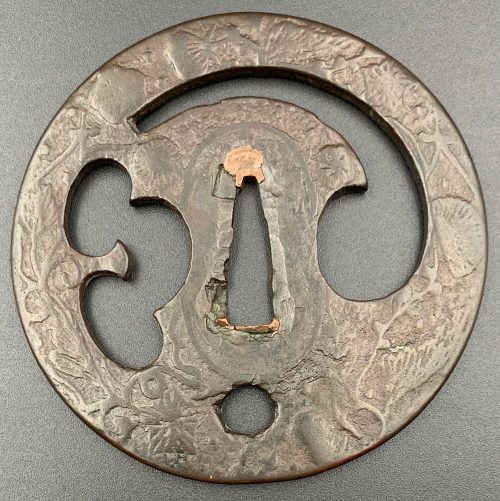
Yamagane (bronze) tsuba (kagami-shi, or mirror-maker) with the design of a star (round opening), tomoe (comma), and suhama in openwork. Surface cast and chiselled with the design of foliage, vines, blossoms, pine needles, and fruits on both sides.
The end of Early Muromachi period (1393-1453), circa 1450. Size: 83.7 x 84.1 x 3.6 (center), 4.1 (rim) mm; weight: 135.5 g. KANTEI-SHO (鑑定書) - APPRAISAL [translated by Markus Sesko]. No 463341 Tomoe-suhama-sukashi hana-karakusa no zu tsuba (巴洲浜透花唐草図鐔) ‒ Tsuba with stylized comma and bay inlet openwork and a flower and arabesque décor Unsigned: Kagami-shi (鏡師) Round shape, yamagane, hammer blow finish, cast, negative openwork design, round rim. According to the result of the shinsa committee of our society, we judge this work as authentic and rank it as Hozon Tōsōgu. July 1, 2011 [Foundation] Nihon Bijutsu Tōken Hozon Kyōkai, NBTHK (日本美術刀劍保存協會) -
 Iron tsuba of round form with design of wheel (kuruma) in openwork (sukashi). Squared rim. Copper sekigane. Yagyu school. Signed of the face: Fukui Tsuguzaemon. Early Edo period: Late 17th century (Kanbun/Enppo era). Height: 76.7 mm. Width: 76.8 mm. Rim thickness: 5.2 mm. Center thickness: 5.6 mm. Provenance: Sasano Masayuki Collection, № 203: "This design of spoke wheel relates to the 'circular principle' found in the Yagyu philosophy. Although it is very faint, Fukui Tsuguzaemon's signature is visible. Without a signature and based on appearance alone, it would undoubtable attributed to a later period".
Iron tsuba of round form with design of wheel (kuruma) in openwork (sukashi). Squared rim. Copper sekigane. Yagyu school. Signed of the face: Fukui Tsuguzaemon. Early Edo period: Late 17th century (Kanbun/Enppo era). Height: 76.7 mm. Width: 76.8 mm. Rim thickness: 5.2 mm. Center thickness: 5.6 mm. Provenance: Sasano Masayuki Collection, № 203: "This design of spoke wheel relates to the 'circular principle' found in the Yagyu philosophy. Although it is very faint, Fukui Tsuguzaemon's signature is visible. Without a signature and based on appearance alone, it would undoubtable attributed to a later period".Merrily Baird in her book "Symbols of Japan" [Merrily Baird. Symbols of Japan. Thematic motifs in art and design. Rizzoli international publications, Inc., 2001] provides the following explanation of the Wheel-of-the-Law symbol: "The Wheel-of-the-Law or Golden Wheel (rimbo, kinrin) has its origins in India, where it is known as chakra. [...] In Buddhist practice, it has been represented with eight spokes, reflecting the eight-fold path to overcoming worldly desire, and it signifies that all illusions will be crushed by the faith's enlightenment. [...] The Wheel-of-the-Law is an attribute of such deities as Senju Kannon, the Thousand-Armed Kannon, and Dainichi Nyorai, the all-illuminating solar figure who is the principal deity for Shingon Buddhism. From the Edo period on, the wheel also has been used in a secular manner", e.g. on family crests.
-
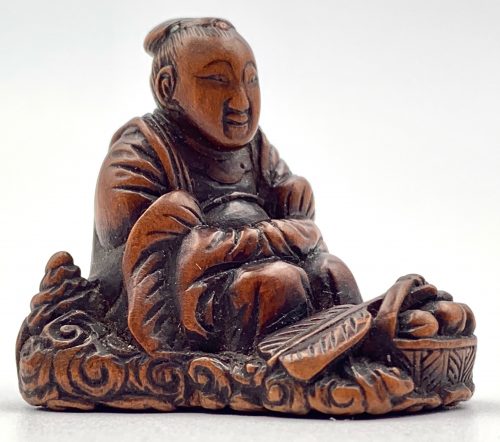 Wood netsuke of Seiōbo with a basket of immortal peaches, seated on a bed of clouds. Carver's signature tablet lost. Circa 1850. Dimensions: 32.6 x 28.1 x 20.1 mm.
Wood netsuke of Seiōbo with a basket of immortal peaches, seated on a bed of clouds. Carver's signature tablet lost. Circa 1850. Dimensions: 32.6 x 28.1 x 20.1 mm.Queen Mother of the West is a calque of Xiwangmu in Chinese sources, Seiōbo in Japan. Peaches of Immortality (Chinese: 仙桃) are consumed by the immortals due to their mystic virtue of conferring longevity on all who eat them.
Provenance: Charles Ephrussi (1849-1905) acquired in the 1870s; a wedding gift in 1898 to his cousin Ritter Viktor von Ephrussi (1860-1945) and Baroness Emilie (Emmy) Schey von Koromla (1879-1938); retrieved post-war by their daughter Elizabeth de Waal (1899-1991); given by her to her brother Ignaz (Iggie) Ephrussi (1906-1994), Tokyo; bequeathed by him to his great-nephew Edmund de Waal (born 1964), London, author of “The Hare with Amber Eyes: a hidden inheritance”. London / New York: Chatto & Windus / Farrar, Straus & Giroux. ISBN 978-0099539551. https://en.wikipedia.org/wiki/Charles_Ephrussi. https://en.wikipedia.org/wiki/Ephrussi_family. https://en.wikipedia.org/wiki/Edmund_de_Waal. -
 Seiro ehon nenju gyoji 青楼絵本年中行事 (A Picture Book of Annual Events in Yoshiwara). Block cut by: Fuji Kazumune (藤一宗). Printed by: Jakushodo Toemon (霍松堂藤右衛門). Written by: Jippensha Ikku (十返舎一九) (text, kyoka 4 & 12). Published by: Kazusaya Chusuke (上総屋忠助). Print artist: Kitagawa Utamaro (喜多川歌麿). Written by: Sandara Boshi (三陀羅法師) (kyoka 1). Workshop of: Yashiki no Katamaru (屋職堅丸). 1804 (spring); Edo. Reference: British Museum; Fine Arts Museums of San Francisco.
Seiro ehon nenju gyoji 青楼絵本年中行事 (A Picture Book of Annual Events in Yoshiwara). Block cut by: Fuji Kazumune (藤一宗). Printed by: Jakushodo Toemon (霍松堂藤右衛門). Written by: Jippensha Ikku (十返舎一九) (text, kyoka 4 & 12). Published by: Kazusaya Chusuke (上総屋忠助). Print artist: Kitagawa Utamaro (喜多川歌麿). Written by: Sandara Boshi (三陀羅法師) (kyoka 1). Workshop of: Yashiki no Katamaru (屋職堅丸). 1804 (spring); Edo. Reference: British Museum; Fine Arts Museums of San Francisco. -
 Artist: Utagawa Yoshitsuya [歌川 芳艶] (Japanese, 1822 – 1866). Publisher: Kojimaya Jūbei [小島屋重兵衛] (Japanese, c. 1797 – 1869). Date seal and double nanushi censor seals: Kunigasa & Yoshimura, Kōka 5 (1849). Signed: Ichieisai Yoshitsuya ga [英斎芳艶画] in a red double gourd cartouche. Two men are fishing with a net off the coast of Shinagawa, in the Edo Bay.
Artist: Utagawa Yoshitsuya [歌川 芳艶] (Japanese, 1822 – 1866). Publisher: Kojimaya Jūbei [小島屋重兵衛] (Japanese, c. 1797 – 1869). Date seal and double nanushi censor seals: Kunigasa & Yoshimura, Kōka 5 (1849). Signed: Ichieisai Yoshitsuya ga [英斎芳艶画] in a red double gourd cartouche. Two men are fishing with a net off the coast of Shinagawa, in the Edo Bay. -
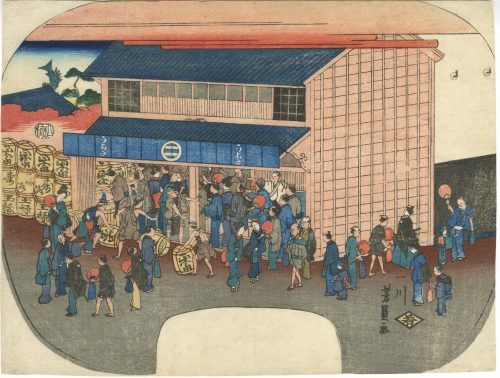 Artist: Utagawa Yoshikazu [歌川芳員] (Japanese, fl. c. 1850 – 1870). Publisher: Wakasaya Yoichi [若狭屋与市] (Japanese, fl. 1794 – 1897). Combined date seal and kiwame censor seal: 1861 (Man'en 2 / Bunkyū 1, from 19/02).
Artist: Utagawa Yoshikazu [歌川芳員] (Japanese, fl. c. 1850 – 1870). Publisher: Wakasaya Yoichi [若狭屋与市] (Japanese, fl. 1794 – 1897). Combined date seal and kiwame censor seal: 1861 (Man'en 2 / Bunkyū 1, from 19/02). -
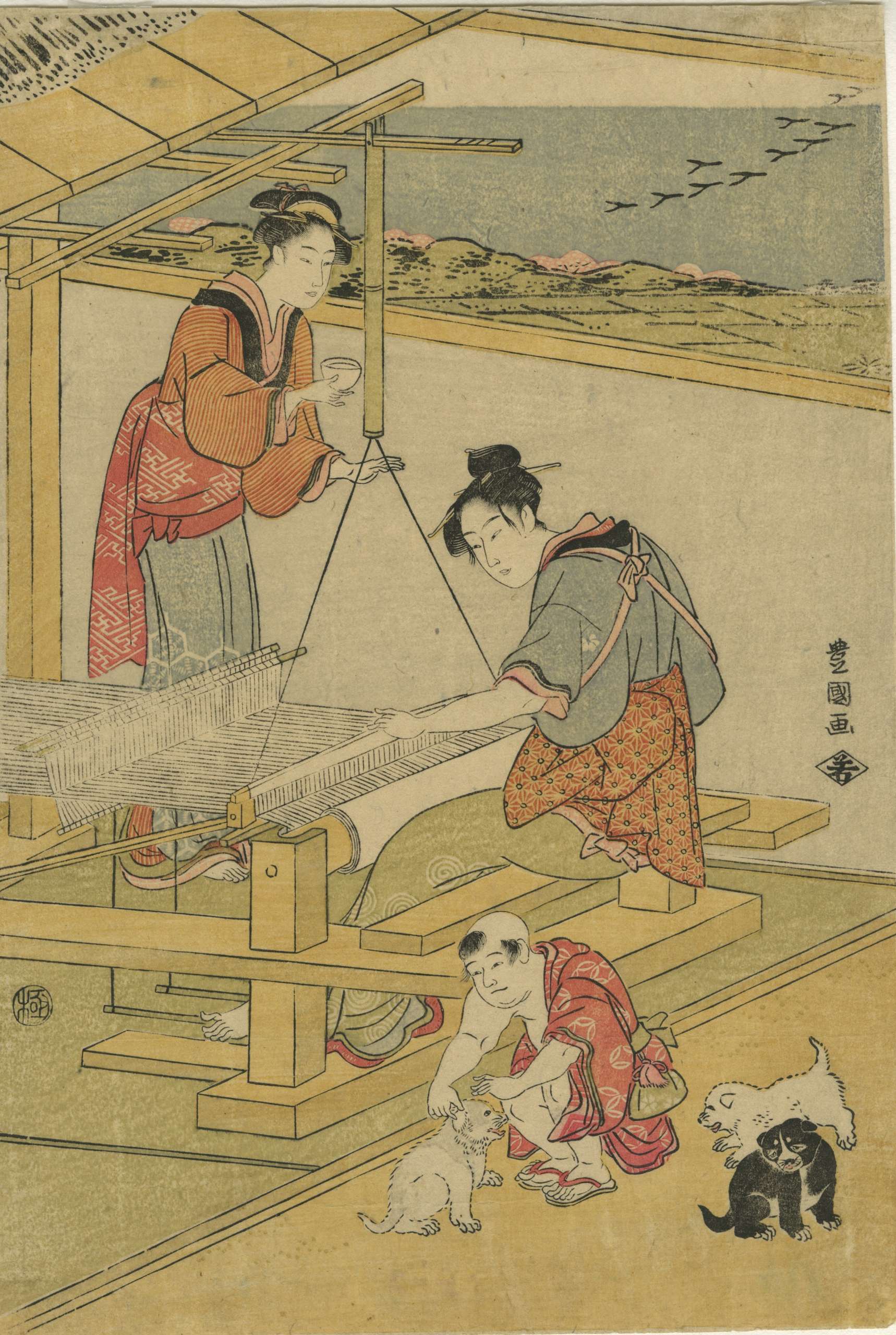 Utagawa Toyokuni I. Women Weaving and Boy Playing with Puppies. c. 1790's. Publisher Wakasaya Yoichi (Jakurindô). Vertical aiban; 32.2 x 21.5 cm (12 11/16 x 8 7/16 in.). MFA ACCESSION NUMBER 06.671. Signed Toyokuni ga 豊国画. Censor's seal: kiwame 改印:極 SOLD
Utagawa Toyokuni I. Women Weaving and Boy Playing with Puppies. c. 1790's. Publisher Wakasaya Yoichi (Jakurindô). Vertical aiban; 32.2 x 21.5 cm (12 11/16 x 8 7/16 in.). MFA ACCESSION NUMBER 06.671. Signed Toyokuni ga 豊国画. Censor's seal: kiwame 改印:極 SOLD -
 Artist: Utagawa Toyokuni I [歌川豊国] (1769–1825). Pubisher: Enshūya Matabei (遠州屋又兵衛) (c. 1768 – 1881), seal name: Enmata [ 遠又]. Signed: Toyokuni ga [豊国画]. Date-aratame censor seal: 未改, Bunsei 6 (1823). Size: uchiwa-e; 233 x 262 mm. Ref: Israel Goldman. Japanese Prints, Paintings and Books / Catalogue 28, 2022: № 14.
Artist: Utagawa Toyokuni I [歌川豊国] (1769–1825). Pubisher: Enshūya Matabei (遠州屋又兵衛) (c. 1768 – 1881), seal name: Enmata [ 遠又]. Signed: Toyokuni ga [豊国画]. Date-aratame censor seal: 未改, Bunsei 6 (1823). Size: uchiwa-e; 233 x 262 mm. Ref: Israel Goldman. Japanese Prints, Paintings and Books / Catalogue 28, 2022: № 14. -
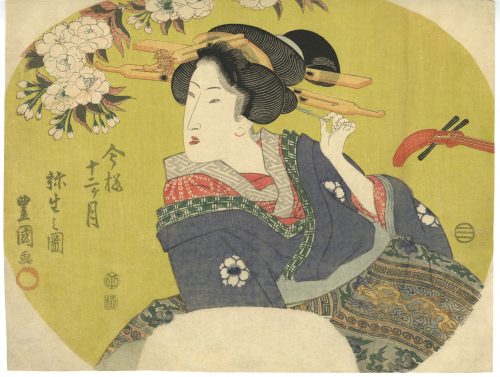 Title: Third lunar month [弥生] (Yayoi no zu); Series: Fashionable Twelve Months (Imayo juni-kagetsu). Another version of translation: Modern Beauties of Twelve Months. Artist: Utagawa Toyokuni I [歌川豊国] (1769–1825). Pubisher: Ibaya Senzaburō [伊場屋仙三郎] (Japanese, 1815 – 1869), seal: Dansendō [伊場仙]. Signed: Toyokuni ga and sealed with toshidama. Date-kiwame seal: Ushi (ox), Bunsei 5 (1822). Size: double-sheet uncut fan print ( aiban uchiwa-e), 219 x 295 mm.
Title: Third lunar month [弥生] (Yayoi no zu); Series: Fashionable Twelve Months (Imayo juni-kagetsu). Another version of translation: Modern Beauties of Twelve Months. Artist: Utagawa Toyokuni I [歌川豊国] (1769–1825). Pubisher: Ibaya Senzaburō [伊場屋仙三郎] (Japanese, 1815 – 1869), seal: Dansendō [伊場仙]. Signed: Toyokuni ga and sealed with toshidama. Date-kiwame seal: Ushi (ox), Bunsei 5 (1822). Size: double-sheet uncut fan print ( aiban uchiwa-e), 219 x 295 mm.

-
 Artist: Utagawa Toyokuni I (1769–1825) Title: Actors Bando Mitsugorō, Ichikawa Danjūrō, Onoe Kikugorō in play The Maiden at Dōjō Temple. Presumably Bunka 13 (1816) at Nakamura Theater in Edo. Publisher: Mikawaya Seiemon (c. 1805-1829); Marks' "Publishers" № 328, p. 235. Size: Vertical ôban MEDIUM OR TECHNIQUE: Woodblock print (nishiki-e); ink and color on paper. Signed: Toyokuni ga Censor's seal: kiwame Detailed discussion on the topic can be seen at: The Maiden at Dōjō Temple
Artist: Utagawa Toyokuni I (1769–1825) Title: Actors Bando Mitsugorō, Ichikawa Danjūrō, Onoe Kikugorō in play The Maiden at Dōjō Temple. Presumably Bunka 13 (1816) at Nakamura Theater in Edo. Publisher: Mikawaya Seiemon (c. 1805-1829); Marks' "Publishers" № 328, p. 235. Size: Vertical ôban MEDIUM OR TECHNIQUE: Woodblock print (nishiki-e); ink and color on paper. Signed: Toyokuni ga Censor's seal: kiwame Detailed discussion on the topic can be seen at: The Maiden at Dōjō Temple -
 Utagawa Toyokuni (歌川豐國); 1769 – 24 February 1825. The actor Nakamura Utaemon as Ishikawa Goemon. Circa 1810. Size/Format: Oban, 9.75 by 14.5 inches
Utagawa Toyokuni (歌川豐國); 1769 – 24 February 1825. The actor Nakamura Utaemon as Ishikawa Goemon. Circa 1810. Size/Format: Oban, 9.75 by 14.5 inches -
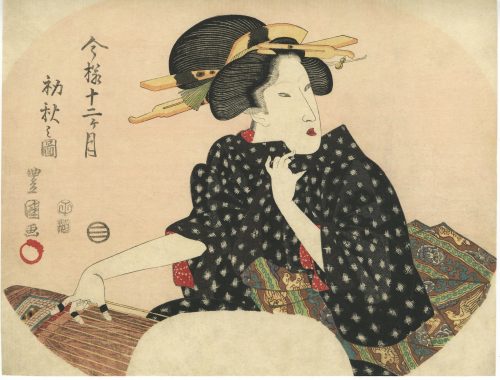 Title: Seventh lunar month [初秋] (Hatsuaki no zu); Series: Fashionable Twelve Months (Imayo juni-kagetsu). Another version of translation: Modern Beauties of Twelve Months. Artist: Utagawa Toyokuni I [歌川豊国] (1769–1825). Pubisher: Ibaya Senzaburō [伊場屋仙三郎] (Japanese, 1815 – 1869), seal: Dansendō [伊場仙]. Signed: Toyokuni ga and sealed with toshidama. Date-kiwame seal: Ushi (ox), Bunsei 5 (1822). Size: double-sheet uncut fan print ( aiban uchiwa-e), 219 x 295 mm.
Title: Seventh lunar month [初秋] (Hatsuaki no zu); Series: Fashionable Twelve Months (Imayo juni-kagetsu). Another version of translation: Modern Beauties of Twelve Months. Artist: Utagawa Toyokuni I [歌川豊国] (1769–1825). Pubisher: Ibaya Senzaburō [伊場屋仙三郎] (Japanese, 1815 – 1869), seal: Dansendō [伊場仙]. Signed: Toyokuni ga and sealed with toshidama. Date-kiwame seal: Ushi (ox), Bunsei 5 (1822). Size: double-sheet uncut fan print ( aiban uchiwa-e), 219 x 295 mm.

-
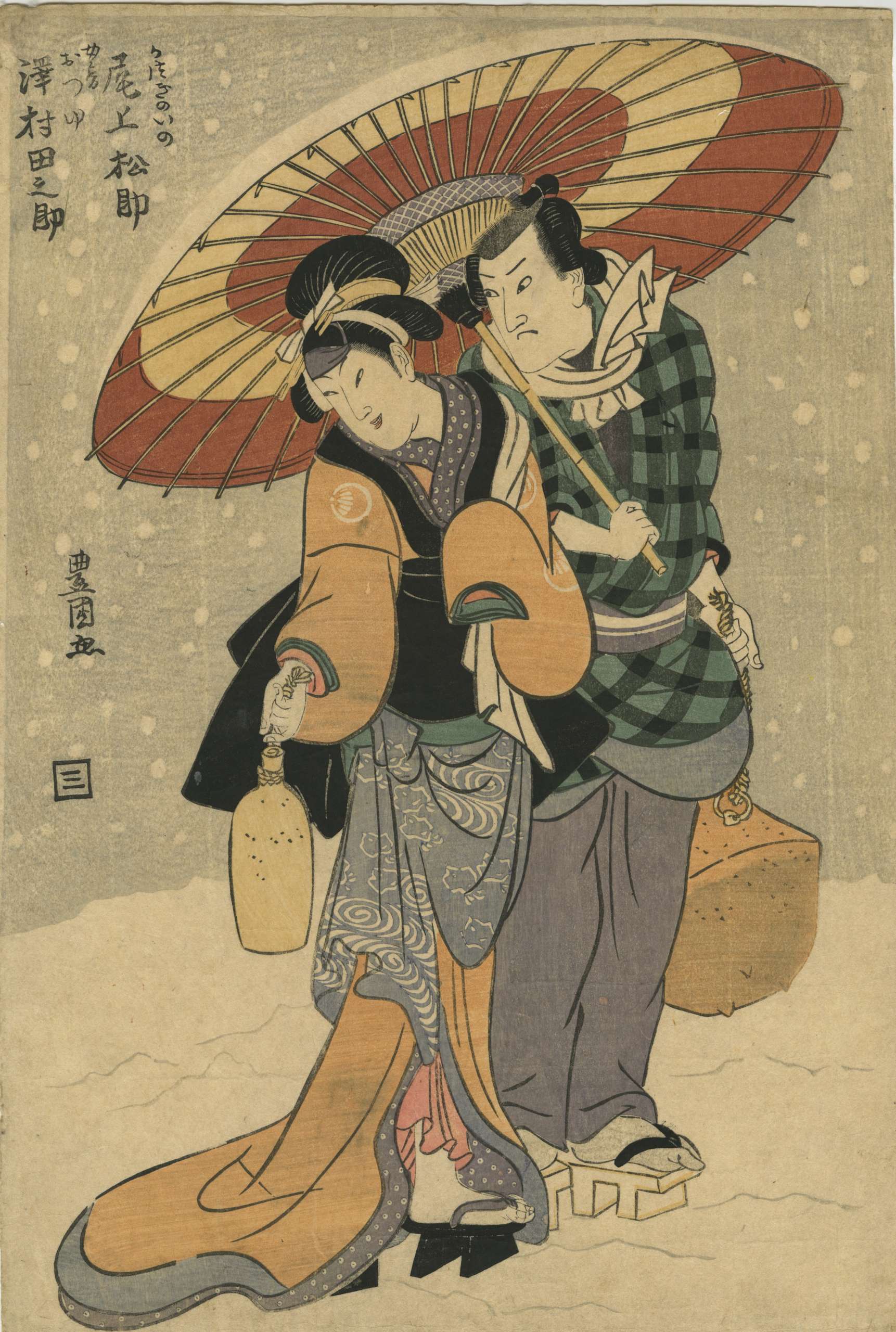 Utagawa Toyokuni (歌川豐國); 1769 – 24 February 1825. Actor Onoe Matsusuke II as Katsugiino (right), actor Sawamura Tanosuke II as Otsuyu (left) 尾上松助(二代目)in a role かつぎいの; 沢村田之助(二代目) in a role おつゆ. Play: "Yuki to Tsuki Hana no Kuronushi". Theater: Nakamura. Publisher: Mikawaua Seiemon (1805-1829) [Marks: 328]. Circa 1810.
Utagawa Toyokuni (歌川豐國); 1769 – 24 February 1825. Actor Onoe Matsusuke II as Katsugiino (right), actor Sawamura Tanosuke II as Otsuyu (left) 尾上松助(二代目)in a role かつぎいの; 沢村田之助(二代目) in a role おつゆ. Play: "Yuki to Tsuki Hana no Kuronushi". Theater: Nakamura. Publisher: Mikawaua Seiemon (1805-1829) [Marks: 328]. Circa 1810. -
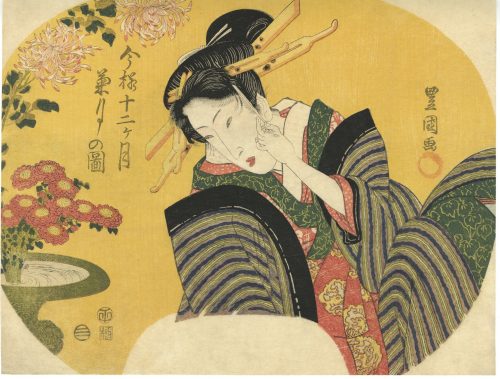 Title: Ninth lunar month [菊月] (Kikuzuki no zu); Series: Fashionable Twelve Months (Imayo juni-kagetsu). Another version of translation: Modern Beauties of Twelve Months. Artist: Utagawa Toyokuni I [歌川豊国] (1769–1825). Pubisher: Ibaya Senzaburō [伊場屋仙三郎] (Japanese, 1815 – 1869), seal: Dansendō [伊場仙]. Signed: Toyokuni ga and sealed with toshidama. Date-kiwame seal: Ushi (ox), Bunsei 5 (1822). Size: double-sheet uncut fan print ( aiban uchiwa-e), 219 x 295 mm.
Title: Ninth lunar month [菊月] (Kikuzuki no zu); Series: Fashionable Twelve Months (Imayo juni-kagetsu). Another version of translation: Modern Beauties of Twelve Months. Artist: Utagawa Toyokuni I [歌川豊国] (1769–1825). Pubisher: Ibaya Senzaburō [伊場屋仙三郎] (Japanese, 1815 – 1869), seal: Dansendō [伊場仙]. Signed: Toyokuni ga and sealed with toshidama. Date-kiwame seal: Ushi (ox), Bunsei 5 (1822). Size: double-sheet uncut fan print ( aiban uchiwa-e), 219 x 295 mm.

-
 Artist: Utagawa Toyokuni I [歌川豊国] (1769–1825). Title: 「しなのやおこん 瀬川菊之丞」「帯屋長右衛門 嵐雛助」 Kabuki play: Katsuragawa Renri no Shigarami [桂川連理柵]. According to Waseda University Cultural Resource Database, the play was performed at Ichimura-za (Edo) on the 2nd month of Kansei 12 (year 1800) under the title 楼門五山桐 さんもんごさんのきり. Publisher: Nishimuraya Yohachi [西村屋与八] (Japanese, c. 1751 – 1869)., Play by Suga Sensuke [菅専助] (ca. 1728 – 1791) in two acts. First performed at Kita Horie-za in Osaka in October 1776. Based on a real incident occurring sometime in the Kyōhō era (1716-35), this story was first dramatized in 1761. The first Kabuki drama to stem from this play was in 1777 at Osaka's Araki-za. Obiya Chōemon, a married obi merchant (sitting with abacus) in his forties, meets his neighbour's daughter Ohan (standing behind Obiya), who is young enough to be his daughter, at an inn in Ishibe; the two fall in love and pledged their troth. Ohan becomes pregnant. After a series of misfortunes, the lovers rush to Katsuragawa (Katsura River), where they drown themselves.
Artist: Utagawa Toyokuni I [歌川豊国] (1769–1825). Title: 「しなのやおこん 瀬川菊之丞」「帯屋長右衛門 嵐雛助」 Kabuki play: Katsuragawa Renri no Shigarami [桂川連理柵]. According to Waseda University Cultural Resource Database, the play was performed at Ichimura-za (Edo) on the 2nd month of Kansei 12 (year 1800) under the title 楼門五山桐 さんもんごさんのきり. Publisher: Nishimuraya Yohachi [西村屋与八] (Japanese, c. 1751 – 1869)., Play by Suga Sensuke [菅専助] (ca. 1728 – 1791) in two acts. First performed at Kita Horie-za in Osaka in October 1776. Based on a real incident occurring sometime in the Kyōhō era (1716-35), this story was first dramatized in 1761. The first Kabuki drama to stem from this play was in 1777 at Osaka's Araki-za. Obiya Chōemon, a married obi merchant (sitting with abacus) in his forties, meets his neighbour's daughter Ohan (standing behind Obiya), who is young enough to be his daughter, at an inn in Ishibe; the two fall in love and pledged their troth. Ohan becomes pregnant. After a series of misfortunes, the lovers rush to Katsuragawa (Katsura River), where they drown themselves.Segawa Kikunojō III (Japanese, 1751 – 1810); other names: Segawa Senjo, Segawa Rokō III, Segawa Tomisaburō I, Ichiyama Tomisaburō, Ichiyama Shichinosuke. The actor held the name of Segawa Kikunojō III from the 11th lunar month of 1774 to the 7th lunar month of 1801. He surpassed all the actors of his time in both female and male roles, especially in the former, and achieved tremendous public acclaim.
Arashi Hinasuke II [嵐雛助] (Japanese, c. 1774 – 1801); other names: Nakamura Jūzō III, Kanō Hidenosuke I, Arashi Hidenosuke I. The actor held the name of Arashi Hinasuke II from the 1st lunar month of 1794 to the 2nd lunar month of 1801. Hi died in Edo on the 4th day of the 2nd lunar month of 1801. For the same characters illustrated by Utagawa Kuniyoshi see SVJP-0333.2021. Sources:
Sources:
- Historical Dictionary of Japanese Traditional Theatre By Samuel L. Leiter. Second edition, 2014.
- Kabuki Encyclopedia. An English-Langauge Adaptation of Kabuki Jiten. Samuel L. Leiter. Greenwood Press, 1979.
- http://www.kabuki21.com/
- Waseda University Cultural Resource Database
-
 UTAGAWA TOYOKUNI I (1769–1825) Ichikawa Danjūrō VII (Ebizo V) in a shibaraku costume bursting through a paper screen. Surimono. Colour woodblock print: shikishiban, 8⅛ x 7⅛ in. (20.7 x 18.2 cm) Signed: Toyokuni ga Poem signed: Sakuragawa Jihinari Provenance: Sidney C. Ward
UTAGAWA TOYOKUNI I (1769–1825) Ichikawa Danjūrō VII (Ebizo V) in a shibaraku costume bursting through a paper screen. Surimono. Colour woodblock print: shikishiban, 8⅛ x 7⅛ in. (20.7 x 18.2 cm) Signed: Toyokuni ga Poem signed: Sakuragawa Jihinari Provenance: Sidney C. Ward -
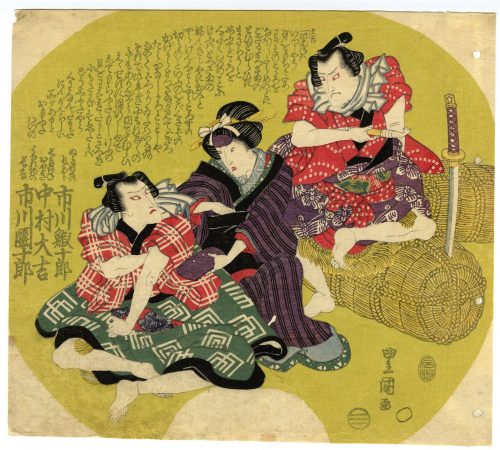 Artist: Utagawa Toyokuni I [歌川豊国] (1769–1825). Publisher: Ibaya Senzaburō [伊場屋 仙三郎] (fl. 1815 – 1869). Signed: Toyokuni ga [豊国 画]. Publisher's seal: Ibaya Sensaburō (Marks 08-067 | 127b). Date-aratame seal: Bunsei 3 (1820). Size: Uncut fan print (uchiwa-e), 224 x 254 mm. Ichikawa Ebijūrō I as Nuregami Chōgorō [濡髪の長五郎], Nakamura Daikichi as Hanaregoma Oseki [放駒のお関], and Ichikawa Danjūrō VII as Hanaregoma Chōkichi [放駒長吉] in a kabuki play Futatsu Chôchô Kuruwa Nikki [双蝶々曲輪日記] (A Diary of Two Butterflies in the Pleasure Quarters (see: LIB-0879.2015 | Brandon, James R., Leiter, Samuel L. Kabuki Plays on Stage: Brilliance and Bravado, 1697-1766 (Volume 1). — Honolulu: University of Hawai'i Press, 2002.) The play was performed at Kawarasakiza (Edo) in May of 1820. Actors: Ichikawa Ebijūrō I [市川鰕十郎] (Japanese, 1777 – 1827); other names: Ichikawa Ichizō I [市川市蔵], Ichinokawa Ichizō [市ノ川市蔵]. Nakamura Daikichi I [初代中村大吉](Japanese, 1773 – 1823); other names: Fujikawa Daikichi [藤川大吉]; poetry name Hajō [巴丈]; pen name Naruo Yatarō [藤川大吉]. Ichikawa Danjūrō VII 市川団十郎 (Japanese, 1791 – 1859); other names: Ichikawa Ebizō V, Ichikawa Hakuen II, Ichikawa Shinnosuke I.
Artist: Utagawa Toyokuni I [歌川豊国] (1769–1825). Publisher: Ibaya Senzaburō [伊場屋 仙三郎] (fl. 1815 – 1869). Signed: Toyokuni ga [豊国 画]. Publisher's seal: Ibaya Sensaburō (Marks 08-067 | 127b). Date-aratame seal: Bunsei 3 (1820). Size: Uncut fan print (uchiwa-e), 224 x 254 mm. Ichikawa Ebijūrō I as Nuregami Chōgorō [濡髪の長五郎], Nakamura Daikichi as Hanaregoma Oseki [放駒のお関], and Ichikawa Danjūrō VII as Hanaregoma Chōkichi [放駒長吉] in a kabuki play Futatsu Chôchô Kuruwa Nikki [双蝶々曲輪日記] (A Diary of Two Butterflies in the Pleasure Quarters (see: LIB-0879.2015 | Brandon, James R., Leiter, Samuel L. Kabuki Plays on Stage: Brilliance and Bravado, 1697-1766 (Volume 1). — Honolulu: University of Hawai'i Press, 2002.) The play was performed at Kawarasakiza (Edo) in May of 1820. Actors: Ichikawa Ebijūrō I [市川鰕十郎] (Japanese, 1777 – 1827); other names: Ichikawa Ichizō I [市川市蔵], Ichinokawa Ichizō [市ノ川市蔵]. Nakamura Daikichi I [初代中村大吉](Japanese, 1773 – 1823); other names: Fujikawa Daikichi [藤川大吉]; poetry name Hajō [巴丈]; pen name Naruo Yatarō [藤川大吉]. Ichikawa Danjūrō VII 市川団十郎 (Japanese, 1791 – 1859); other names: Ichikawa Ebizō V, Ichikawa Hakuen II, Ichikawa Shinnosuke I. -
 Title: Fourth lunar month [卯月] (Uzuki no zu); Series: Fashionable Twelve Months (Imayo juni-kagetsu). Another version of translation: Modern Beauties of Twelve Months. Artist: Utagawa Toyokuni I [歌川豊国] (1769–1825). Pubisher: Ibaya Senzaburō [伊場屋仙三郎] (Japanese, 1815 – 1869), seal: Dansendō [伊場仙]. Signed: Toyokuni ga and sealed with toshidama. Date-kiwame seal: Ushi (ox), Bunsei 5 (1822). Size: double-sheet uncut fan print ( aiban uchiwa-e), 219 x 295 mm.
Title: Fourth lunar month [卯月] (Uzuki no zu); Series: Fashionable Twelve Months (Imayo juni-kagetsu). Another version of translation: Modern Beauties of Twelve Months. Artist: Utagawa Toyokuni I [歌川豊国] (1769–1825). Pubisher: Ibaya Senzaburō [伊場屋仙三郎] (Japanese, 1815 – 1869), seal: Dansendō [伊場仙]. Signed: Toyokuni ga and sealed with toshidama. Date-kiwame seal: Ushi (ox), Bunsei 5 (1822). Size: double-sheet uncut fan print ( aiban uchiwa-e), 219 x 295 mm.

-
 Title: Eleventh lunar month (Chuto no zu); Series: Fashionable Twelve Months (Imayo juni-kagetsu). Another version of translation: Modern Beauties of Twelve Months. Artist: Utagawa Toyokuni I [歌川豊国] (1769–1825). Pubisher: Ibaya Senzaburō [伊場屋仙三郎] (Japanese, 1815 – 1869), seal: Dansendō [伊場仙]. Signed: Toyokuni ga and sealed with toshidama. Date-kiwame seal: Ushi (ox), Bunsei 5 (1822). Size: double-sheet uncut fan print ( aiban uchiwa-e), 219 x 295 mm.
Title: Eleventh lunar month (Chuto no zu); Series: Fashionable Twelve Months (Imayo juni-kagetsu). Another version of translation: Modern Beauties of Twelve Months. Artist: Utagawa Toyokuni I [歌川豊国] (1769–1825). Pubisher: Ibaya Senzaburō [伊場屋仙三郎] (Japanese, 1815 – 1869), seal: Dansendō [伊場仙]. Signed: Toyokuni ga and sealed with toshidama. Date-kiwame seal: Ushi (ox), Bunsei 5 (1822). Size: double-sheet uncut fan print ( aiban uchiwa-e), 219 x 295 mm.

-
 Title: Early Spring [初春之図] (Hatsuharu no zu); Series: Fashionable Twelve Months [今様十二ヶ月] (Imayo juni-kagetsu). Another version of translation: Modern Beauties of Twelve Months. Artist: Utagawa Toyokuni I [歌川豊国] (1769–1825). Pubisher: Ibaya Senzaburō [伊場屋仙三郎] (Japanese, 1815 – 1869), seal: Dansendō [伊場仙]. Signed: Toyokuni ga [豊国画] and sealed with toshidama. Date-kiwame seal: Ushi (ox), Bunsei 5 (1822). Size: double-sheet uncut fan print ( aiban uchiwa-e), each 217 x 288 mm. Ref: Tokyo Museum Collection.
Title: Early Spring [初春之図] (Hatsuharu no zu); Series: Fashionable Twelve Months [今様十二ヶ月] (Imayo juni-kagetsu). Another version of translation: Modern Beauties of Twelve Months. Artist: Utagawa Toyokuni I [歌川豊国] (1769–1825). Pubisher: Ibaya Senzaburō [伊場屋仙三郎] (Japanese, 1815 – 1869), seal: Dansendō [伊場仙]. Signed: Toyokuni ga [豊国画] and sealed with toshidama. Date-kiwame seal: Ushi (ox), Bunsei 5 (1822). Size: double-sheet uncut fan print ( aiban uchiwa-e), each 217 x 288 mm. Ref: Tokyo Museum Collection.
Other five prints of this series: SVJP 0326.2020; SVJP-0362.2022; SVJP-0363.2022; SVJP-0364.2022; SVJP-0365.2022.

-
 Utagawa Toyokuni I (歌川豐國); 1769 – 24 February 1825. Kabuki actor Onoe Matsusuke I (other stage names: Onoe Shôroku I and Onoe Tokuzô) lived from 1744 (born in Edo, present Tokyo) until the 16th day of the 10th lunar month of 1815 (died in Edo). Here he plays the honourable villain, the powerful minister of state Kudō Saemon Suketsune. Kabuki actor Bandô Hikosaburô III (other stage names: Ichimura Kichigorô I, other names: Hansôan Rakuzen, Bandô Shinsui III, and Rakuzenbô) lived from 1754 (born in Edo, present Tokyo) until 18th day of the 2nd lunar month of 1828. "1813 ~ 1828: Hikosaburô retires and takes the tonsure in a Temple located in Kurodani (Kyôto). He goes back to Edo and lives a hermit life in a small hut called Hansôan and located in Mukôjima." Here he plays Soga no Gorō Tokimune, the younger of two Soga brothers. It was an Edo period custom to produce every New Year's a play in which the Soga brothers figured. The Sogas were actual historical figures who, in 1193, avenged their father's murder by staging a daring night raid on their enemy during a grand hunt. The villain, a powerful minister of state named Kudō Saemon Suketsune, had orchestrated the murder of their father seventeen years earlier. The exact play, theater, and year featured on the print are not currently known. Publisher: AM-23-016 |391q: Nishimuraya Yohachi: Eiju han 1780s-1809 [AM: Andreas Marks. Publishers of Japanese woodblock prints: A compendium. Hotei Publishing, Leiden-Boston, 2011]. References:
Utagawa Toyokuni I (歌川豐國); 1769 – 24 February 1825. Kabuki actor Onoe Matsusuke I (other stage names: Onoe Shôroku I and Onoe Tokuzô) lived from 1744 (born in Edo, present Tokyo) until the 16th day of the 10th lunar month of 1815 (died in Edo). Here he plays the honourable villain, the powerful minister of state Kudō Saemon Suketsune. Kabuki actor Bandô Hikosaburô III (other stage names: Ichimura Kichigorô I, other names: Hansôan Rakuzen, Bandô Shinsui III, and Rakuzenbô) lived from 1754 (born in Edo, present Tokyo) until 18th day of the 2nd lunar month of 1828. "1813 ~ 1828: Hikosaburô retires and takes the tonsure in a Temple located in Kurodani (Kyôto). He goes back to Edo and lives a hermit life in a small hut called Hansôan and located in Mukôjima." Here he plays Soga no Gorō Tokimune, the younger of two Soga brothers. It was an Edo period custom to produce every New Year's a play in which the Soga brothers figured. The Sogas were actual historical figures who, in 1193, avenged their father's murder by staging a daring night raid on their enemy during a grand hunt. The villain, a powerful minister of state named Kudō Saemon Suketsune, had orchestrated the murder of their father seventeen years earlier. The exact play, theater, and year featured on the print are not currently known. Publisher: AM-23-016 |391q: Nishimuraya Yohachi: Eiju han 1780s-1809 [AM: Andreas Marks. Publishers of Japanese woodblock prints: A compendium. Hotei Publishing, Leiden-Boston, 2011]. References:- Kabuki Plays on Stage: Brilliance and Bravado, 1697-1766 (Kabuki Plays on Stage, Volume 1). Brandon, James R., Leiter, Samuel L. University of Hawai'I Press, Honolulu, 2002.
- Kabuki Encyclopedia. An English-Langauge Adaptation of Kabuki Jiten. Samuel L. Leiter. Greenwood Press, 1979.
- https://www.kabuki21.com/
-
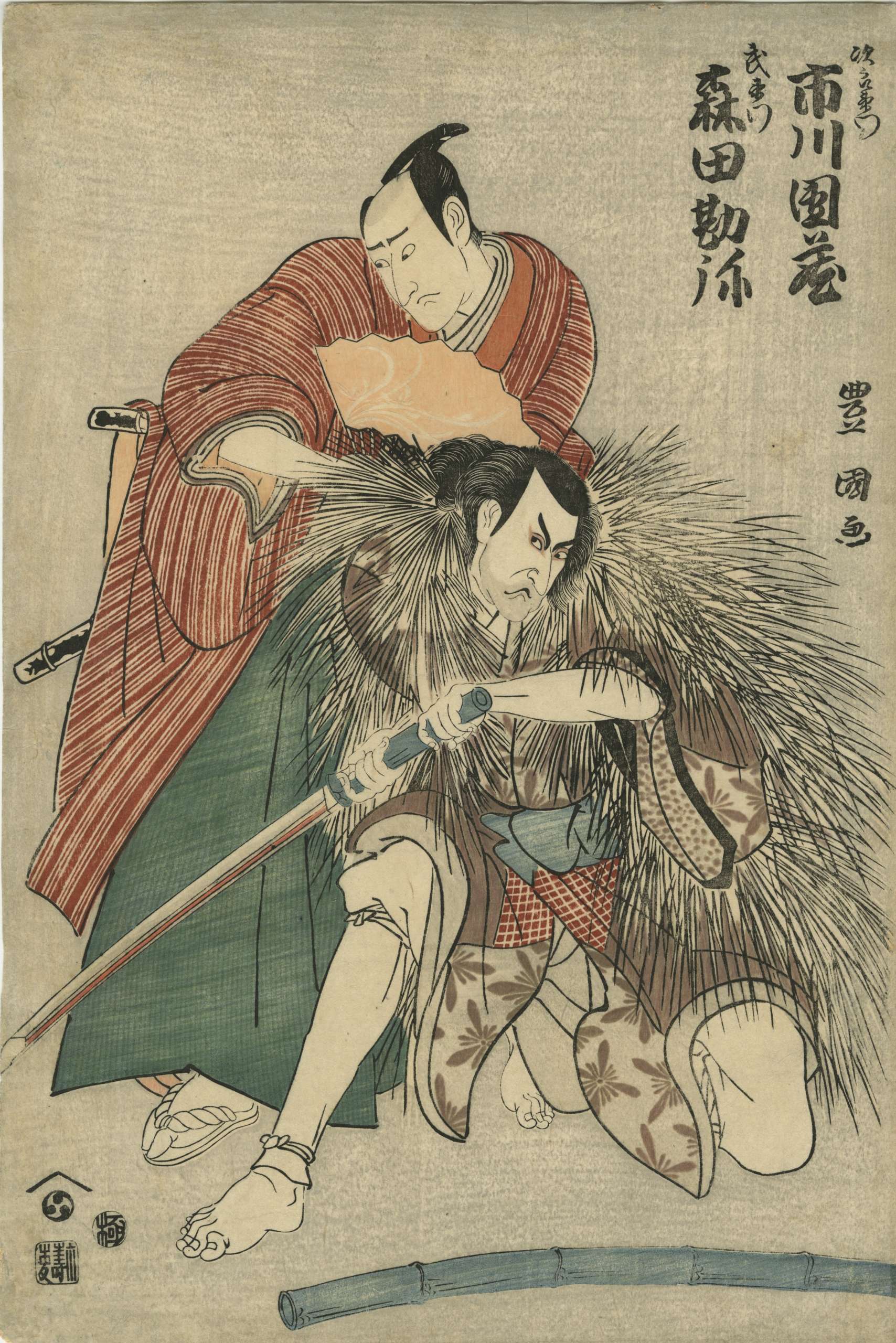 Utagawa Toyokuni (歌川豐國); 1769 – 24 February 1825. The kabuki actors Ichikawa Danzo IV as Jiroemon (in draw cape) and Morita Kanya VIII as Buemon. Play 'Oriai Tsuzure no Nishiki', performed at the Moritaza Theater in the 7th month of 1798. Publisher: Eijudo.
Utagawa Toyokuni (歌川豐國); 1769 – 24 February 1825. The kabuki actors Ichikawa Danzo IV as Jiroemon (in draw cape) and Morita Kanya VIII as Buemon. Play 'Oriai Tsuzure no Nishiki', performed at the Moritaza Theater in the 7th month of 1798. Publisher: Eijudo. -
 Similar image at MFA under title: Actors and Women in the Snow MFA ACCESSION NUMBER: 11.13568 Date: 1809 (Bunka 6), 12th month Artist: Utagawa Toyokuni I (1769–1825) Publisher Tsuruya Kinsuke (firm name Sôkakudô), № 554 in Marks's "Publishers". DIMENSIONS: Vertical ôban; 38.2 x 25.8 cm (15 1/16 x 10 3/16 in.) MEDIUM OR TECHNIQUE: Woodblock print (nishiki-e); ink and color on paper. Signed: Toyokuni ga (豊国画) Censor's seals: kiwame (改印:極) MFA assumes that this may be "one sheet of incomplete triptych?"
Similar image at MFA under title: Actors and Women in the Snow MFA ACCESSION NUMBER: 11.13568 Date: 1809 (Bunka 6), 12th month Artist: Utagawa Toyokuni I (1769–1825) Publisher Tsuruya Kinsuke (firm name Sôkakudô), № 554 in Marks's "Publishers". DIMENSIONS: Vertical ôban; 38.2 x 25.8 cm (15 1/16 x 10 3/16 in.) MEDIUM OR TECHNIQUE: Woodblock print (nishiki-e); ink and color on paper. Signed: Toyokuni ga (豊国画) Censor's seals: kiwame (改印:極) MFA assumes that this may be "one sheet of incomplete triptych?" -
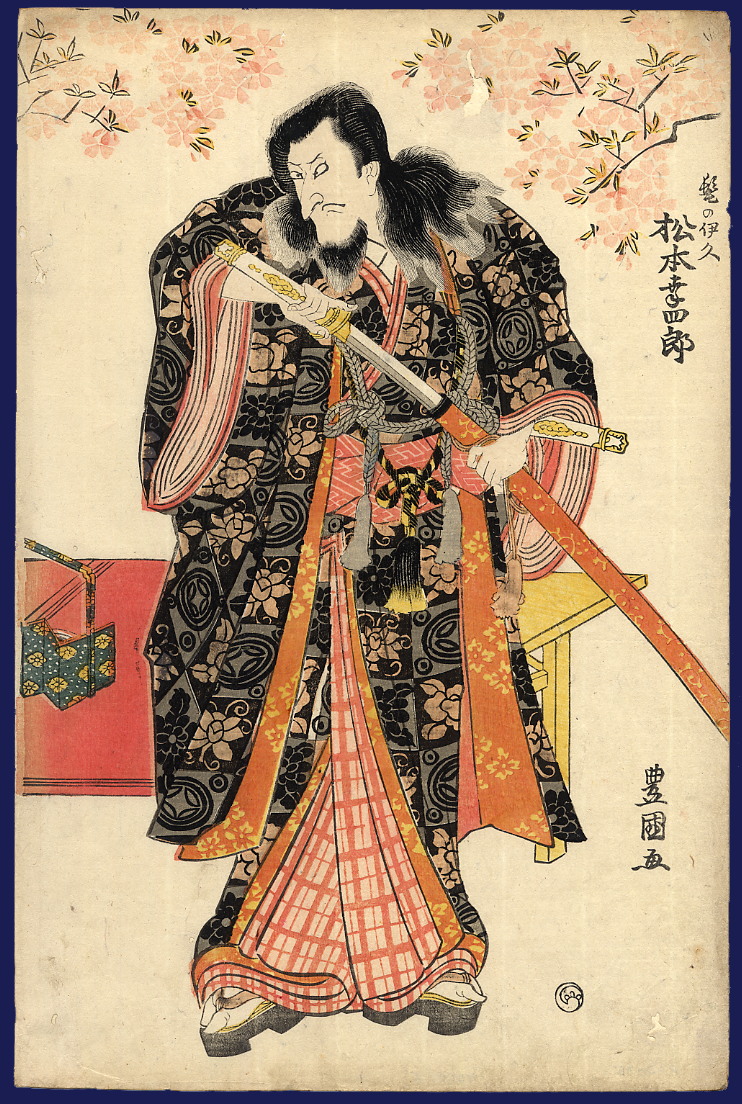 Artist: Utagawa Toyokuni I (1769–1825) Actor Matsumoto Kōshirō V plays the role of Ikyû in the drama "Sukeroku Yukari no Edo Zakura". The roles of Sukeroku and the courtesan Agemaki are played by Ichikawa Danjûrô VII and Iwai Hanshirô V". Ichimura Theater in Edo in 2nd lunar month of 1811. Publisher: Chōjiya Kichi (1811-1826); Marks' "Publishers" № 028, p. 103. Size: Vertical ôban Woodblock print (nishiki-e); ink and color on paper. Signed: Toyokuni ga My print is the right sheet of a triptych (see: Rare books exhibition in January 2013).
Artist: Utagawa Toyokuni I (1769–1825) Actor Matsumoto Kōshirō V plays the role of Ikyû in the drama "Sukeroku Yukari no Edo Zakura". The roles of Sukeroku and the courtesan Agemaki are played by Ichikawa Danjûrô VII and Iwai Hanshirô V". Ichimura Theater in Edo in 2nd lunar month of 1811. Publisher: Chōjiya Kichi (1811-1826); Marks' "Publishers" № 028, p. 103. Size: Vertical ôban Woodblock print (nishiki-e); ink and color on paper. Signed: Toyokuni ga My print is the right sheet of a triptych (see: Rare books exhibition in January 2013). A lookalike triptych by Kunisada can be found in Ronin Gallery:
A lookalike triptych by Kunisada can be found in Ronin Gallery:
 Data from Kabuki21:
Stage names:
Matsumoto Kôshirô V, Ichikawa Komazô III, Ichikawa Sumizô I
Guild: Kôraiya
Line number: GODAIME (V)
Poetry names: Kinshô, Kinkô
Existence: 1764 ~ 10th day of the 5th lunar month of 1838
Connection:
Father: Matsumoto Kôshirô IV
Sons: Matsumoto Kôshirô VI, Ichikawa Sumizô II
Disciples: Matsumoto Kojirô, Matsumoto Kingo I, Matsumoto Hidejûrô II
Data from Kabuki21:
Stage names:
Matsumoto Kôshirô V, Ichikawa Komazô III, Ichikawa Sumizô I
Guild: Kôraiya
Line number: GODAIME (V)
Poetry names: Kinshô, Kinkô
Existence: 1764 ~ 10th day of the 5th lunar month of 1838
Connection:
Father: Matsumoto Kôshirô IV
Sons: Matsumoto Kôshirô VI, Ichikawa Sumizô II
Disciples: Matsumoto Kojirô, Matsumoto Kingo I, Matsumoto Hidejûrô II
Matsumoto Kôshirô V was one of the Kabuki giants, a senryô yakusha, during the Bunka, Bunsei and Tenpô eras. In his 20's he was a tachiyaku actor excelling in nimaime roles like Soga Jûrô Sukenari in sogamono dramas. He started to perform jitsuaku roles from the 11th lunar month of 1798 and quickly became one of the best actors for villain roles, especially in Tsuruya Nanboku IV's kizewamono. He had a considerable influence on actors like Onoe Kikugorô III or Ichikawa Danjûrô VII. The kata he deviced for some of the most famous roles in Kabuki history, like Gonta ("Sushiya") or Nikki Danjô* ("Meiboku Sendai Hagi") are still used nowadays. "The fifth Kôshirô had a very large nose and his eyes were close together, two facial defects the print artists were fond of depicting, so that this Edo actor is easily picked out in the pictures illustrating the theatre of this time." (Zoë Kincaid in "Kabuki, the Popular Stage of Japan")
-
 Artist: Utagawa Toyohiro [歌川豐廣] (Japanese, 1773 – 1828) Publisher: Takasu Soshichi (Marks 25-247 / 517) Size: pillar print (hashira-e), 69.2 x 13 cm.
Artist: Utagawa Toyohiro [歌川豐廣] (Japanese, 1773 – 1828) Publisher: Takasu Soshichi (Marks 25-247 / 517) Size: pillar print (hashira-e), 69.2 x 13 cm.Signed: Toyohiro ga [豐廣画]
Catalogue raisonné: Jacob Pins, The Japanese Pillar Print, № 923, p. 326. -
 Artist: Utagawa Sadahide [歌川 貞秀], a.k.a. Gountei Sadahide [五雲亭 貞秀] (1807 – c. 1878/9). Signed: Gountei Sadahide ga [五雲亭貞秀画] Pubisher: Ibaya Senzaburō [伊場屋仙三郎] (Japanese, 1815 – 1869) Date-aratame seal: Bunsei 13 / Tenpō 1 (1830). Ref: Ritsumeikan University # Z0172-587. Title: Yukari no Edo-zakura [ゆかりの江戸桜], often translated into English as 'The Flower of Edo', is a one-act kabuki play Sukeroku, written by Tsuuchi Han'emon (fl. 1701 – 1743) under the supervision of Tsuuchi Jihei II (1673 – 1760 ) at the beginning of the 18th century. From the beginning of the 19th century, the play was performed in the style of katōbushi. 助六所縁江戸桜(すけろくゆかりのえどざくら。「助六」– one of the main melodies in katōbushi (河東節) type of jōruri [浄瑠璃]. For a detailed explanation in Japanese, see also HERE). Plot: In search of the stolen Minamoto clan's precious sword called Tomokirimaru, Soga Gorō (historical Soga Tokimune [曾我時致], 1174 – 1193) came to a Yoshiwara brothel under the disguise of a debaucher named Hanagawado Sukeroku. His elder brother, Soga Jūrō (historical Soga Sukenari [曾我祐成], 1172 – 1193) ), has assumed the guise of a wine vendor Shinbei. The character who had the Tomokirimaru sword was Ikyū (historical Iga no Heinaizaemon, a Tiara clan's ally), see SVJP-0164.2014. A series of three prints is dedicated to a katōbushi performance of the Soga-themed plays.
Artist: Utagawa Sadahide [歌川 貞秀], a.k.a. Gountei Sadahide [五雲亭 貞秀] (1807 – c. 1878/9). Signed: Gountei Sadahide ga [五雲亭貞秀画] Pubisher: Ibaya Senzaburō [伊場屋仙三郎] (Japanese, 1815 – 1869) Date-aratame seal: Bunsei 13 / Tenpō 1 (1830). Ref: Ritsumeikan University # Z0172-587. Title: Yukari no Edo-zakura [ゆかりの江戸桜], often translated into English as 'The Flower of Edo', is a one-act kabuki play Sukeroku, written by Tsuuchi Han'emon (fl. 1701 – 1743) under the supervision of Tsuuchi Jihei II (1673 – 1760 ) at the beginning of the 18th century. From the beginning of the 19th century, the play was performed in the style of katōbushi. 助六所縁江戸桜(すけろくゆかりのえどざくら。「助六」– one of the main melodies in katōbushi (河東節) type of jōruri [浄瑠璃]. For a detailed explanation in Japanese, see also HERE). Plot: In search of the stolen Minamoto clan's precious sword called Tomokirimaru, Soga Gorō (historical Soga Tokimune [曾我時致], 1174 – 1193) came to a Yoshiwara brothel under the disguise of a debaucher named Hanagawado Sukeroku. His elder brother, Soga Jūrō (historical Soga Sukenari [曾我祐成], 1172 – 1193) ), has assumed the guise of a wine vendor Shinbei. The character who had the Tomokirimaru sword was Ikyū (historical Iga no Heinaizaemon, a Tiara clan's ally), see SVJP-0164.2014. A series of three prints is dedicated to a katōbushi performance of the Soga-themed plays.
They all have a background of hail patterns (Arare-ko-mon) [霰小紋], similar to Kunisada’s Iwai Kumesaburō II as An no Heibei [SVJP-0304.2019], see below.Yukari no Edo-zakura The tatami night robe of Iwao Tangled Hair and the Evening Braided Hat 
-
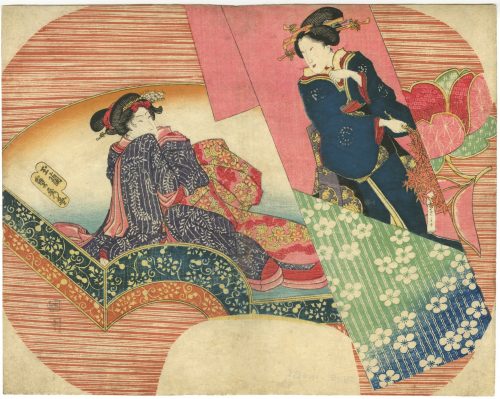 Artist: Utagawa Sadahide [歌川貞秀] (Japanese, 1807 – 1879). Publisher: Kojimaya Jūbei [小島屋重兵衛] (Japanese, c. 1797 – 1869); seal: Marks #264, p. 210) Signed: Gyokuransai Sadahide ga [玉蘭斎貞秀 画]. Date seal: 1830 (Bunsei 13 / Tenpō 1). Size: Uncut fan print (uchiwa-e); 229 x 292 mm
Artist: Utagawa Sadahide [歌川貞秀] (Japanese, 1807 – 1879). Publisher: Kojimaya Jūbei [小島屋重兵衛] (Japanese, c. 1797 – 1869); seal: Marks #264, p. 210) Signed: Gyokuransai Sadahide ga [玉蘭斎貞秀 画]. Date seal: 1830 (Bunsei 13 / Tenpō 1). Size: Uncut fan print (uchiwa-e); 229 x 292 mm -
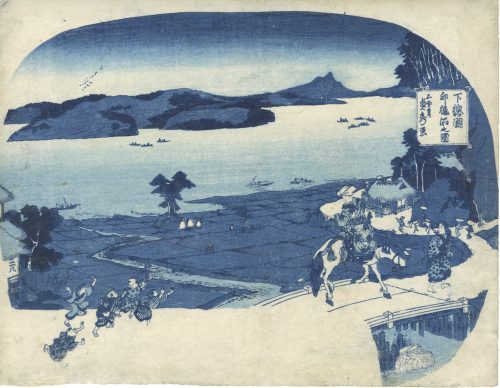 An uncut aizuri fan print showing travellers arriving at Inba Lake [印旛沼] (Inba-numa) on Shimosa Plateau [下総台地] (Shimōsa-daichi). Artist: Utagawa Sadahide [歌川貞秀] (Japanese, 1807 – 1879) Publisher: Unknown. Published: c. 1849. Signed: Gountei Sadahide ga [五雲亭 貞秀画] (Picture by Gountei Sadahide). Inscription in cartouche: Shimosa Plateau, Inbanuma (Inba Lake) [下總國印幡沼]. No date seal, no censor seal (privately printed?) Media: Fan print [団扇絵] (uchiwa-e), 235 x 300 mm.
An uncut aizuri fan print showing travellers arriving at Inba Lake [印旛沼] (Inba-numa) on Shimosa Plateau [下総台地] (Shimōsa-daichi). Artist: Utagawa Sadahide [歌川貞秀] (Japanese, 1807 – 1879) Publisher: Unknown. Published: c. 1849. Signed: Gountei Sadahide ga [五雲亭 貞秀画] (Picture by Gountei Sadahide). Inscription in cartouche: Shimosa Plateau, Inbanuma (Inba Lake) [下總國印幡沼]. No date seal, no censor seal (privately printed?) Media: Fan print [団扇絵] (uchiwa-e), 235 x 300 mm. -
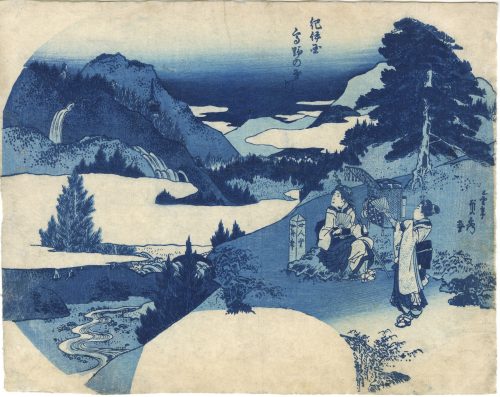 An uncut aizuri fan print showing two travellers admiring the view of the Tama River [多摩川] (Tamagawa) and Mount Kōya [高野山] (Kōyasan) in Kii Province [紀伊国] (Kii no Kuni). Artist: Utagawa Sadahide [歌川貞秀] (Japanese, 1807 – 1879). Signed: Gountei Sadahide ga [五雲亭貞秀画] (Picture by Gountei Sadahide). Publisher: Unknown. Published: c. 1849. No date seal, no censor seal (privately printed?) Media: Fan print [団扇絵] (uchiwa-e), 235 x 300 mm.
An uncut aizuri fan print showing two travellers admiring the view of the Tama River [多摩川] (Tamagawa) and Mount Kōya [高野山] (Kōyasan) in Kii Province [紀伊国] (Kii no Kuni). Artist: Utagawa Sadahide [歌川貞秀] (Japanese, 1807 – 1879). Signed: Gountei Sadahide ga [五雲亭貞秀画] (Picture by Gountei Sadahide). Publisher: Unknown. Published: c. 1849. No date seal, no censor seal (privately printed?) Media: Fan print [団扇絵] (uchiwa-e), 235 x 300 mm. -
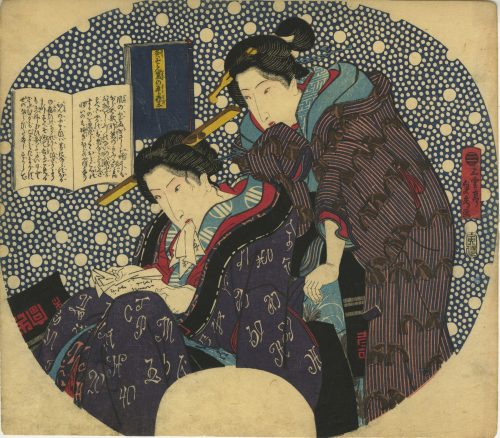 Artist: Utagawa Sadahide [歌川 貞秀], a.k.a. Gountei Sadahide [五雲亭 貞秀] (1807 – c. 1878/9). Signed: Gountei Sadahide ga [五雲亭貞秀画] Pubisher: Ibaya Senzaburō [伊場屋仙三郎] (Japanese, 1815 – 1869) Date-aratame seal: Bunsei 13 / Tenpō 1 (1830). Ref: Ritsumeikan University # Z0172-587. Title: The tatami night robe of Iwao [巌の畳夜着] (Kyusue Iwao no tatami yogi); 灸すゑ巌の畳夜着(きゅうすえいわおのたたみよぎ。「灸すえ」– one of the main melodies in katōbushi (河東節) type of jōruri [浄瑠璃]. For a detailed explanation in Japanese, see also HERE). The night robe of Iwao is decorated with characters resembling Arabic numerals, and Latin and Cyrillic letters. A similar kimono can be seen on Kunisada's print Hotoke Gozen, Mirror of Virtuous and Wise Women (Kenjo Kagami) at RISD museum accession number 13.1383, portraying Hotoke Gozen (佛御前), a character of The Tale of the Heike [平家物語] (Heike Monogatari); published by Yamamotoya Heikichi (山本屋平吉) (Japanese, fl. c. 1812 – 1886) in the 1830s (see below).A series of three prints is dedicated to a katōbushi performance of the Soga-themed plays.
Artist: Utagawa Sadahide [歌川 貞秀], a.k.a. Gountei Sadahide [五雲亭 貞秀] (1807 – c. 1878/9). Signed: Gountei Sadahide ga [五雲亭貞秀画] Pubisher: Ibaya Senzaburō [伊場屋仙三郎] (Japanese, 1815 – 1869) Date-aratame seal: Bunsei 13 / Tenpō 1 (1830). Ref: Ritsumeikan University # Z0172-587. Title: The tatami night robe of Iwao [巌の畳夜着] (Kyusue Iwao no tatami yogi); 灸すゑ巌の畳夜着(きゅうすえいわおのたたみよぎ。「灸すえ」– one of the main melodies in katōbushi (河東節) type of jōruri [浄瑠璃]. For a detailed explanation in Japanese, see also HERE). The night robe of Iwao is decorated with characters resembling Arabic numerals, and Latin and Cyrillic letters. A similar kimono can be seen on Kunisada's print Hotoke Gozen, Mirror of Virtuous and Wise Women (Kenjo Kagami) at RISD museum accession number 13.1383, portraying Hotoke Gozen (佛御前), a character of The Tale of the Heike [平家物語] (Heike Monogatari); published by Yamamotoya Heikichi (山本屋平吉) (Japanese, fl. c. 1812 – 1886) in the 1830s (see below).A series of three prints is dedicated to a katōbushi performance of the Soga-themed plays.
RISDM 13-1383
They all have a background of hail patterns (Arare-ko-mon) [霰小紋], similar to Kunisada’s Iwai Kumesaburō II as An no Heibei [SVJP-0304.2019], see below.Yukari no Edo-zakura The tatami night robe of Iwao Tangled Hair and the Evening Braided Hat 
-
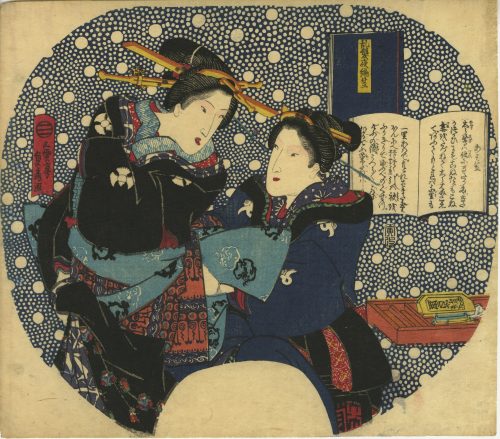 Artist: Utagawa Sadahide [歌川 貞秀], a.k.a. Gountei Sadahide [五雲亭 貞秀] (1807 – c. 1878/9). Signed: Gountei Sadahide ga [五雲亭貞秀画] Pubisher: Ibaya Senzaburō [伊場屋仙三郎] (Japanese, 1815 – 1869) Date-aratame seal: Bunsei 13 / Tenpō 1 (1830). Ref: Ritsumeikan University # Z0172-587. Title: Tangled Hair and the Evening Braided Hat [乱髪夜編笠] (Midaregami Yoru no Amigasa). The open book starts with the chapter title that reads Amigasa. This play was performed together with Kisohajime Hatsugai Soga [着衣始]初買曽我]. See the playbill for the performance at Moritaza at MFA (Boston) № 11.27208. 乱髪夜編笠(みだれがみよるのあみがさ。「夜の編笠」「白さぎ」
Artist: Utagawa Sadahide [歌川 貞秀], a.k.a. Gountei Sadahide [五雲亭 貞秀] (1807 – c. 1878/9). Signed: Gountei Sadahide ga [五雲亭貞秀画] Pubisher: Ibaya Senzaburō [伊場屋仙三郎] (Japanese, 1815 – 1869) Date-aratame seal: Bunsei 13 / Tenpō 1 (1830). Ref: Ritsumeikan University # Z0172-587. Title: Tangled Hair and the Evening Braided Hat [乱髪夜編笠] (Midaregami Yoru no Amigasa). The open book starts with the chapter title that reads Amigasa. This play was performed together with Kisohajime Hatsugai Soga [着衣始]初買曽我]. See the playbill for the performance at Moritaza at MFA (Boston) № 11.27208. 乱髪夜編笠(みだれがみよるのあみがさ。「夜の編笠」「白さぎ」とも)– one of the main melodies in katōbushi (河東節) type of jōruri [浄瑠璃]. For a detailed explanation in Japanese, see also HERE). A series of three prints is dedicated to a katōbushi performance of the Soga-themed plays.
They all have a background of hail patterns (Arare-ko-mon) [霰小紋], similar to Kunisada’s Iwai Kumesaburō II as An no Heibei [SVJP-0304.2019], see below.Yukari no Edo-zakura The tatami night robe of Iwao Tangled Hair and the Evening Braided Hat 
-
 An uncut fan print showing Otsu-e [大津絵] (Otsu pictures). Artist: Utagawa Sadahide [歌川貞秀] (Japanese, 1807 – 1879). Signed: Gountei Sadahide ga [五雲亭貞秀画] (Picture by Gountei Sadahide); characters on the Otsu-e. Publisher: Ibaya Senzaburō [伊場屋仙三郎] (Japanese, c. 1815 – 1869). Published: c. 1849. Inscription in a paper-weight shaped cartouche: [大津追 分絵の図] Ōtsu-oi wake-e no zu (Following Otsu – image of separate pictures) No date seal, no censor seal (privately printed?) Media: Fan print (uchiwa-e, 団扇絵), 235 x 298 mm.
An uncut fan print showing Otsu-e [大津絵] (Otsu pictures). Artist: Utagawa Sadahide [歌川貞秀] (Japanese, 1807 – 1879). Signed: Gountei Sadahide ga [五雲亭貞秀画] (Picture by Gountei Sadahide); characters on the Otsu-e. Publisher: Ibaya Senzaburō [伊場屋仙三郎] (Japanese, c. 1815 – 1869). Published: c. 1849. Inscription in a paper-weight shaped cartouche: [大津追 分絵の図] Ōtsu-oi wake-e no zu (Following Otsu – image of separate pictures) No date seal, no censor seal (privately printed?) Media: Fan print (uchiwa-e, 団扇絵), 235 x 298 mm. -
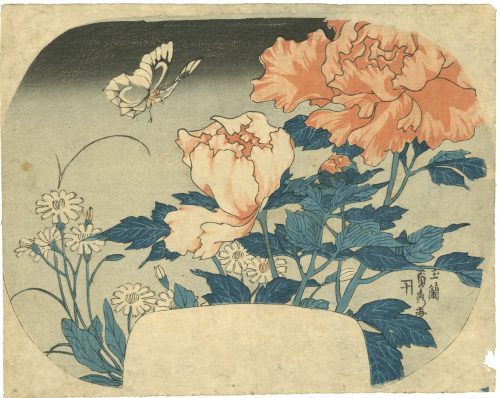 Artist: Utagawa Sadahide [歌川貞秀] (Japanese, 1807 – 1879) Publisher: Kojimaya Jūbei [小島屋重兵衛] (Japanese, c. 1797 – 1869) No date seal, no censor seal (privately printed?) Media: Fan print (uchiwa-e, 団扇絵), 235 x 297 mm. Kalimeris incisa, or Japanese Aster, is a daisy-like flower that belongs to the family of Asteraceae; it blossoms all summer and attracts butterflies. Peony [牡丹] (botan) – per Merrily Baird it is "the king of flowers", associated with erotic love, and especially with the sexual activities of women.
Artist: Utagawa Sadahide [歌川貞秀] (Japanese, 1807 – 1879) Publisher: Kojimaya Jūbei [小島屋重兵衛] (Japanese, c. 1797 – 1869) No date seal, no censor seal (privately printed?) Media: Fan print (uchiwa-e, 団扇絵), 235 x 297 mm. Kalimeris incisa, or Japanese Aster, is a daisy-like flower that belongs to the family of Asteraceae; it blossoms all summer and attracts butterflies. Peony [牡丹] (botan) – per Merrily Baird it is "the king of flowers", associated with erotic love, and especially with the sexual activities of women. -
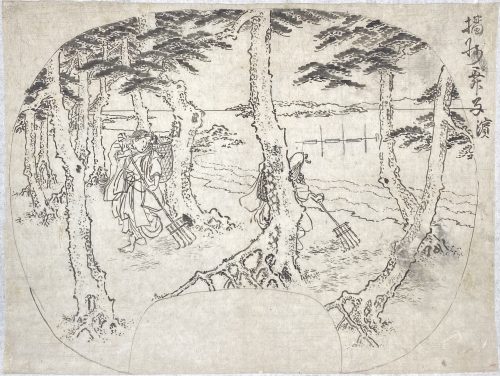 Artist: Veronica Miller attributes the drawing to Utagawa Sadahide [歌川 貞秀] (Japanese, 1807 – 1879), also known as Gountei Sadahide [五雲亭 貞秀]. A preparatory drawing for a fan print depicts two women raking pine needles along the scenic beach at Harima. Inscription at top right "Maiko Beach in Harima" (Harima Maiko no Hama) [播磨 舞子濱], which is now located in Hyōgo Prefecture. The view must be of the Akashi Strait, looking towards Awaji Island. Drawn on thin hanshita paper, mounted lightly at the top to a backing paper, but unbacked. Size: 240 x 319 mm. Attribution to Sadahide based on his design titled "Suma Bay: Matsukaze and Murasame" (see below):
Artist: Veronica Miller attributes the drawing to Utagawa Sadahide [歌川 貞秀] (Japanese, 1807 – 1879), also known as Gountei Sadahide [五雲亭 貞秀]. A preparatory drawing for a fan print depicts two women raking pine needles along the scenic beach at Harima. Inscription at top right "Maiko Beach in Harima" (Harima Maiko no Hama) [播磨 舞子濱], which is now located in Hyōgo Prefecture. The view must be of the Akashi Strait, looking towards Awaji Island. Drawn on thin hanshita paper, mounted lightly at the top to a backing paper, but unbacked. Size: 240 x 319 mm. Attribution to Sadahide based on his design titled "Suma Bay: Matsukaze and Murasame" (see below):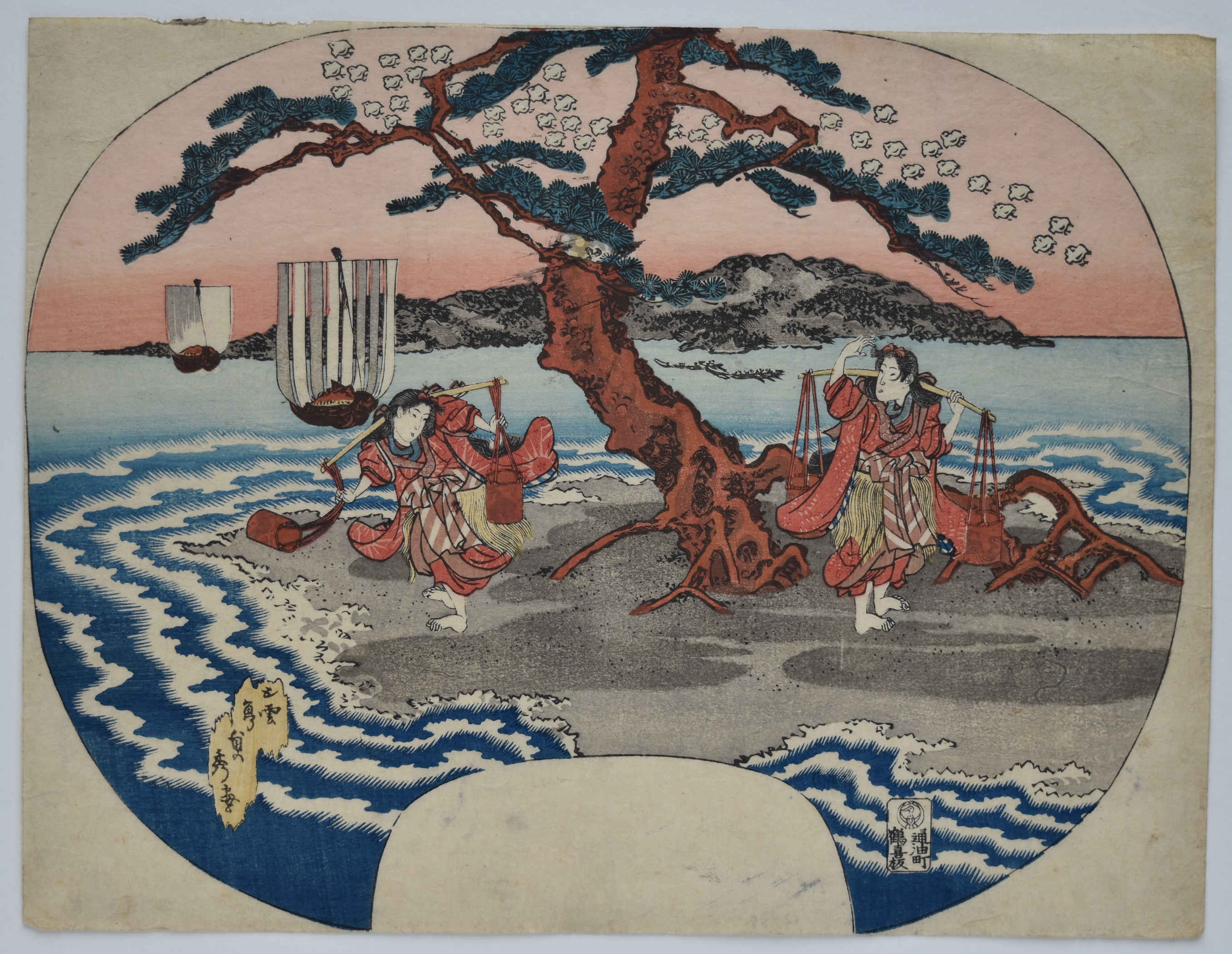 See also Maiko Beach, Harima Province, from the series Views of Famous Places in the Sixty-Odd Provinces,
See also Maiko Beach, Harima Province, from the series Views of Famous Places in the Sixty-Odd Provinces,
-
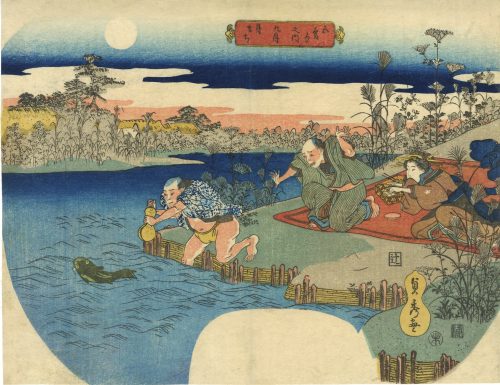 Artist: Utagawa Sadahide [歌川貞秀] (Japanese, 1807 – 1879). Publisher: Iseya Ichiemon [伊勢屋市右衛門] (Japanese, fl. c. 1820s – c. 1860s). Size: Uncut fan print (uchiwa-e), 220 x 285 mm. Date-kiwame seal: 1835 (Tenpō 6). Signed: Sadahide ga in a double-gourd cartouche. Man trying to catch a catfish with a gourd during a picnic on an autumn evening. Five Festivals [五節句の內] (Gosekku no uchi), Ninth Month [九月] (Kugatu), Full moon celebration on the 15th night of the month (Tsuki machi) [月まち] or [月待]. The autumnal spirit is also supported by the presence of Patrinia scabiosifolia (ominaeshi) [女郎花] and Miscanthus sinensis, or Japanese pampas grass (susuki) [薄]. These two are part of the Seven Grasses of Autumn (aki no nanakusa) [秋の七草]. Description by Richard Kruml: "Viewing the full moon in the eighth and ninth months was a popular activity passed down from the aristocracy in Heian times; especially where the moon's reflection could be seen in the water. One such party is seen here where a member vainly attempts to catch a catfish with a gourd: A hopeless task with such an unsuitable utensil. This is based on a Zen riddle posed by the shōgun Ashikaga Yoshimochi [足利 義持] (Japanese, 1386 – 1428) on how to catch a catfish with a gourd, which inspired the 15th-century artist Josetsu [如拙] (Japanese, fl. 1405 – 1496) to paint the subject with accompanying poems on the conundrum by Zen monks".
Artist: Utagawa Sadahide [歌川貞秀] (Japanese, 1807 – 1879). Publisher: Iseya Ichiemon [伊勢屋市右衛門] (Japanese, fl. c. 1820s – c. 1860s). Size: Uncut fan print (uchiwa-e), 220 x 285 mm. Date-kiwame seal: 1835 (Tenpō 6). Signed: Sadahide ga in a double-gourd cartouche. Man trying to catch a catfish with a gourd during a picnic on an autumn evening. Five Festivals [五節句の內] (Gosekku no uchi), Ninth Month [九月] (Kugatu), Full moon celebration on the 15th night of the month (Tsuki machi) [月まち] or [月待]. The autumnal spirit is also supported by the presence of Patrinia scabiosifolia (ominaeshi) [女郎花] and Miscanthus sinensis, or Japanese pampas grass (susuki) [薄]. These two are part of the Seven Grasses of Autumn (aki no nanakusa) [秋の七草]. Description by Richard Kruml: "Viewing the full moon in the eighth and ninth months was a popular activity passed down from the aristocracy in Heian times; especially where the moon's reflection could be seen in the water. One such party is seen here where a member vainly attempts to catch a catfish with a gourd: A hopeless task with such an unsuitable utensil. This is based on a Zen riddle posed by the shōgun Ashikaga Yoshimochi [足利 義持] (Japanese, 1386 – 1428) on how to catch a catfish with a gourd, which inspired the 15th-century artist Josetsu [如拙] (Japanese, fl. 1405 – 1496) to paint the subject with accompanying poems on the conundrum by Zen monks". -
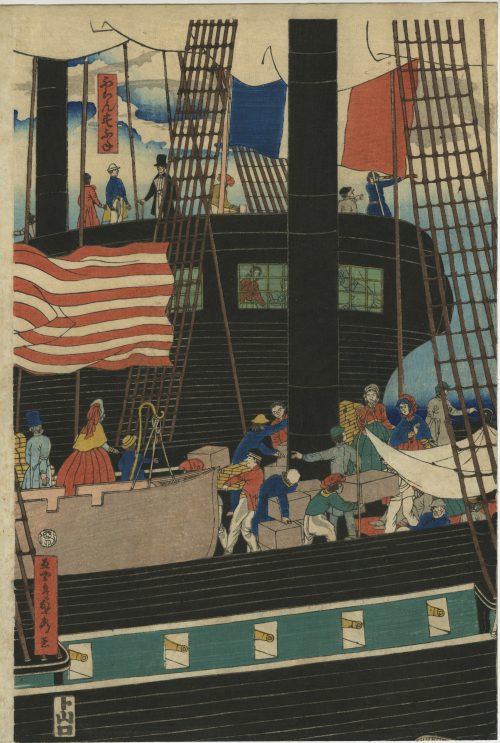 Utagawa Sadahide, a.k.a. Gountei Sadahide (Japanese, 1807 – c. 1878–1879), 五雲亭 貞秀, 歌川 貞秀, Yamaguchiya Tōbei, Yokohama kōeki seiyōjin nimotsu unsō no zu - Western traders loading cargo in Yokohama - 横浜交易西洋人荷物運送之圖, 1861, Woodblock print (nishiki-e); ink and color on paper, Horizontal Ōban Pentaptych: 5 x (37 x 25.5 cm), Alternative title: Picture of Western Traders at Yokohama Transporting Merchandise (Cat. Reisonée: Yokohama ukiyo-e, Yurindo, 1979: №50). Japanese pentaptych print shows an American ship in the harbor at Yokohama, Japan; small boats ferry cargo which is being carried up a gangplank contributing to the bustle of activity on the main deck. April, 1861. SOLD
Utagawa Sadahide, a.k.a. Gountei Sadahide (Japanese, 1807 – c. 1878–1879), 五雲亭 貞秀, 歌川 貞秀, Yamaguchiya Tōbei, Yokohama kōeki seiyōjin nimotsu unsō no zu - Western traders loading cargo in Yokohama - 横浜交易西洋人荷物運送之圖, 1861, Woodblock print (nishiki-e); ink and color on paper, Horizontal Ōban Pentaptych: 5 x (37 x 25.5 cm), Alternative title: Picture of Western Traders at Yokohama Transporting Merchandise (Cat. Reisonée: Yokohama ukiyo-e, Yurindo, 1979: №50). Japanese pentaptych print shows an American ship in the harbor at Yokohama, Japan; small boats ferry cargo which is being carried up a gangplank contributing to the bustle of activity on the main deck. April, 1861. SOLD -
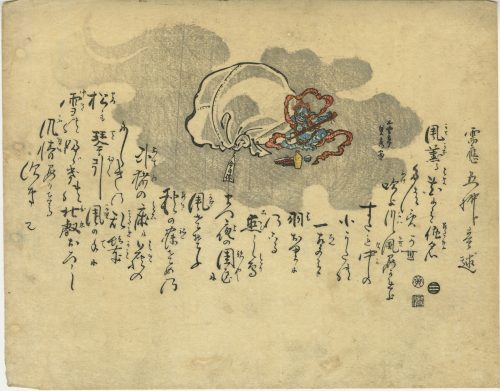 Artist: Utagawa Sadahide [歌川 貞秀], a.k.a. Gountei Sadahide [五雲亭 貞秀] (Japanese, 1807 – c. 1878-9). Publisher: Ibaya Senzaburō [伊場屋仙三郎] (Japanese, c. 1815 – 1869). Date-kiwame seal: 1831 (Tenpō 2). Size: Uchiwa-e, 298 x 232 mm. Pair of uncut fan prints (1) with the god of wind and (2) with the god of thunder meant to be pasted on two sides of a fan.
Artist: Utagawa Sadahide [歌川 貞秀], a.k.a. Gountei Sadahide [五雲亭 貞秀] (Japanese, 1807 – c. 1878-9). Publisher: Ibaya Senzaburō [伊場屋仙三郎] (Japanese, c. 1815 – 1869). Date-kiwame seal: 1831 (Tenpō 2). Size: Uchiwa-e, 298 x 232 mm. Pair of uncut fan prints (1) with the god of wind and (2) with the god of thunder meant to be pasted on two sides of a fan.

-
 Artist: Utagawa Kuniyoshi [歌川 國芳] (Japanese, 1798 – 1861) Publisher: British Museum provides for the title as Enkyoku-zoroi [艶曲揃] (Set of Voluptuous Melodies) and the publisher as Sanpei. Indeed, 三平 (Sanpei) was a wholesale fan shop at the end of the Edo period. However, Andreas Marks identifies the publisher's seal as 三平 Mihei = Mikawaya Heiroku (1848-56), a member of the Fan Producing Guild (AM 11-016|325a). Block carver: Yokokawa Takejirō, seal: Carver Taki [彫竹] (Hori Take)
Artist: Utagawa Kuniyoshi [歌川 國芳] (Japanese, 1798 – 1861) Publisher: British Museum provides for the title as Enkyoku-zoroi [艶曲揃] (Set of Voluptuous Melodies) and the publisher as Sanpei. Indeed, 三平 (Sanpei) was a wholesale fan shop at the end of the Edo period. However, Andreas Marks identifies the publisher's seal as 三平 Mihei = Mikawaya Heiroku (1848-56), a member of the Fan Producing Guild (AM 11-016|325a). Block carver: Yokokawa Takejirō, seal: Carver Taki [彫竹] (Hori Take)Signed: Ichiyosai Kuniyoshi ga in a red cartouche and sealed with paulownia (kiri mon).
Date seal and double nanushi censor seals: Fuku & Muramatsu, 1853 (Kaei 6, 2nd month).
Size: Uchiwa-e (untrimmed fan print) 296 x 230 mm.

SVJP-0303.2019
-
 Series: Pictures Associated with the Iroha Syllabary [伊呂波画合]. Artist: Utagawa Kuniyoshi [歌川 國芳] (1798 – 1861). Signed: Ichiyûsai Kuniyoshi giga [一勇斎 國芳戯画] (Playfully drawn by Ichiyūsai Kuniyoshi) in a red double-gourd cartouche with a kiri-mon seal beneath. Publisher: Iseya Ichiemon [伊勢屋市右衛門] (Japanese, fl. 1823 – c. 1864); seal [辻] (Marks 16-029 | 143a). Single nanushi censor seal: Mura [村] = Murata Sahei [村田佐右衛] (VI/1842 – V/1846). Media: Fan print (uchiwa-e, 団扇絵), 231 x 296 mm. Theme: The Treasury of Loyal Retainers [仮名手本忠臣蔵] (Kanadehon Chūshingura) – an 11-act puppet play composed in 1748, based on a historical event. "Most historians now agree that there were forty-seven rōnin of Ako who attacked and killed Kira Yoshinaka (吉良 義央, 1641 – 1703) in Edo in the twelfth month of 1702, twenty-two months after their lord Asano Naganori (浅野 長矩, 1667 – 1701) had been put to death for his own failed attempt on Kira’s life". [Henry D. SMITH II. The Trouble with Terasaka: The Forty-Seventh Rōnin and the Chūshingura Imagination / Japan Review, 2004, 16:3-65]. The reader shall remember that the fictional, romantic version of the Akō incident [赤穂事件] (Akō jiken) may not (and most probably does not) reflect the historical truth of events. Uncut fan print depicting a beautiful young woman covering another woman's mouth with a blue striped cloth, possibly an obi. The picture on the wall represents the scene from the final act of The Treasury of Loyal Retainers (Kanadehon Chūshingura, Act 11) when 47 loyal retainers (rōnin) of the late lord En'ya Hangan came to the house of Kō no Moronao in order to avenge their dead master. The leader of 47 rōnin, Ōboshi Yuranosuke, divided his accomplices into several groups which attacked the Moronao mansion from different directions. To coordinate the attack and keep communication among the groups, the rōnin were signing the first syllables of their names in the hiragana syllabary. There are two major types of the ordering of the hiragana syllabary, the Gojūon one and the Iroha order (pangram poem), the latter being used here. The number of avengers exactly matches the 47 letters of that syllabary. The group entering Moronao's house from the front gate was 'chi-ri-nu-ru-wo-wa-ka'. Yoshida Sadaemon Kanesada [葦田貞右衛門兼貞] (1675 – 1703) depicted on this fan print belongs to this group. The character on the lantern hanging from Yoshida's spear reads Chū [忠] – for Chūshingura. Alternating black and white triangles on the picture frame allude to the 'signature' 47 ronin's uniform. This motif is usually described as a zigzag pattern [雁木模様] (gangi moyō), a mountain-shaped pattern [山形模様] (yamagata moyō), or a mountain road [山道] (yamamichi). The rōnin were allegedly wearing this uniform in imitation of firefighters. The government allowed the firefighters alone to gather in large groups and carry equipment akin to that of the military. Such equipment was necessary for firemen to tear down the burning buildings to stop the flames. The design can be seen in Kunimaru's fan print [SVJP-0233.2018] in this collection.Fighting Moronao's guards, the 47 rōnin entered the mansion and searched for their enemy but in vain. Finally, Yazama Jujiro Motooki [矢間重次郎元興] found the villain in the charcoal chamber and called his friends. This is the exact moment we see in the picture on the wall: Yoshida entering the charcoal chamber with a spear in his hand amid falling baskets and charcoal. Kō no Moronao was brought to justice and beheaded; his head was offered before the memorial tablet of En'ya Hangan to appease his spirit. After that, Ōboshi Yuranosuke and his 46 friends committed seppuku. They were buried at Sengakuji (泉岳寺) – a small temple near Shinagawa in Edo (Tokyo).
Series: Pictures Associated with the Iroha Syllabary [伊呂波画合]. Artist: Utagawa Kuniyoshi [歌川 國芳] (1798 – 1861). Signed: Ichiyûsai Kuniyoshi giga [一勇斎 國芳戯画] (Playfully drawn by Ichiyūsai Kuniyoshi) in a red double-gourd cartouche with a kiri-mon seal beneath. Publisher: Iseya Ichiemon [伊勢屋市右衛門] (Japanese, fl. 1823 – c. 1864); seal [辻] (Marks 16-029 | 143a). Single nanushi censor seal: Mura [村] = Murata Sahei [村田佐右衛] (VI/1842 – V/1846). Media: Fan print (uchiwa-e, 団扇絵), 231 x 296 mm. Theme: The Treasury of Loyal Retainers [仮名手本忠臣蔵] (Kanadehon Chūshingura) – an 11-act puppet play composed in 1748, based on a historical event. "Most historians now agree that there were forty-seven rōnin of Ako who attacked and killed Kira Yoshinaka (吉良 義央, 1641 – 1703) in Edo in the twelfth month of 1702, twenty-two months after their lord Asano Naganori (浅野 長矩, 1667 – 1701) had been put to death for his own failed attempt on Kira’s life". [Henry D. SMITH II. The Trouble with Terasaka: The Forty-Seventh Rōnin and the Chūshingura Imagination / Japan Review, 2004, 16:3-65]. The reader shall remember that the fictional, romantic version of the Akō incident [赤穂事件] (Akō jiken) may not (and most probably does not) reflect the historical truth of events. Uncut fan print depicting a beautiful young woman covering another woman's mouth with a blue striped cloth, possibly an obi. The picture on the wall represents the scene from the final act of The Treasury of Loyal Retainers (Kanadehon Chūshingura, Act 11) when 47 loyal retainers (rōnin) of the late lord En'ya Hangan came to the house of Kō no Moronao in order to avenge their dead master. The leader of 47 rōnin, Ōboshi Yuranosuke, divided his accomplices into several groups which attacked the Moronao mansion from different directions. To coordinate the attack and keep communication among the groups, the rōnin were signing the first syllables of their names in the hiragana syllabary. There are two major types of the ordering of the hiragana syllabary, the Gojūon one and the Iroha order (pangram poem), the latter being used here. The number of avengers exactly matches the 47 letters of that syllabary. The group entering Moronao's house from the front gate was 'chi-ri-nu-ru-wo-wa-ka'. Yoshida Sadaemon Kanesada [葦田貞右衛門兼貞] (1675 – 1703) depicted on this fan print belongs to this group. The character on the lantern hanging from Yoshida's spear reads Chū [忠] – for Chūshingura. Alternating black and white triangles on the picture frame allude to the 'signature' 47 ronin's uniform. This motif is usually described as a zigzag pattern [雁木模様] (gangi moyō), a mountain-shaped pattern [山形模様] (yamagata moyō), or a mountain road [山道] (yamamichi). The rōnin were allegedly wearing this uniform in imitation of firefighters. The government allowed the firefighters alone to gather in large groups and carry equipment akin to that of the military. Such equipment was necessary for firemen to tear down the burning buildings to stop the flames. The design can be seen in Kunimaru's fan print [SVJP-0233.2018] in this collection.Fighting Moronao's guards, the 47 rōnin entered the mansion and searched for their enemy but in vain. Finally, Yazama Jujiro Motooki [矢間重次郎元興] found the villain in the charcoal chamber and called his friends. This is the exact moment we see in the picture on the wall: Yoshida entering the charcoal chamber with a spear in his hand amid falling baskets and charcoal. Kō no Moronao was brought to justice and beheaded; his head was offered before the memorial tablet of En'ya Hangan to appease his spirit. After that, Ōboshi Yuranosuke and his 46 friends committed seppuku. They were buried at Sengakuji (泉岳寺) – a small temple near Shinagawa in Edo (Tokyo).
Utagawa Kunimaru. Chūshingura, Act 11.
 Another fan print from the same series can be found at Kuniyoshi Project:
Another fan print from the same series can be found at Kuniyoshi Project:
 The same subject is portrayed by Kuniyoshi in the series Mirror of the True Loyalty of the Faithful Retainers [誠忠義臣鏡] (Seichû gishin kagami), publisher: Kagiya Hanjirô, c. 1851 (Kuniyoshi Project) – Yoshida Sadaemon Kanesada (葦田貞右衛門兼貞) raising his sword amid falling baskets and charcoal:
The same subject is portrayed by Kuniyoshi in the series Mirror of the True Loyalty of the Faithful Retainers [誠忠義臣鏡] (Seichû gishin kagami), publisher: Kagiya Hanjirô, c. 1851 (Kuniyoshi Project) – Yoshida Sadaemon Kanesada (葦田貞右衛門兼貞) raising his sword amid falling baskets and charcoal:







